#in which I summarize the source material EVEN FURTHER
Explore tagged Tumblr posts
Text
A Lesson in Modern History: the Other Side
Lecture 1
Ten years and eight months ago, Oz Vessalius was thrown into the Abyss.
This is where every Story begins. The day of this young man's coming-of-age coronation, when the hands on that ancient clock moved, setting fate into motion. And yet, this Story unfolding before us now appears to start somewhere far removed from the events of that evening.
I know this Story well, I've read it dozens of times. The setting changes, the time period differs. The Ending varies, just as much. And yet, I can't predict how this current Story will go.
All that I can do is use this journal to recall the details of the Story I'm most familiar with, (comparing them with the current version as necessary). I do this not for myself, but for the sake of you, the Reader. Call it History, call it Reference, call it Context.
Just make sure you pay attention, and ask questions if you have them.
On the day of his 15th (18th) birthday, Oz and his valet Gilbert were exploring the grounds of one of the Vessalius family's properties when they came across a hidden grave. Though the name had been worn from the headstone, a pocket watch in perfect condition dangled from the stone cross. When wound, the watch played a delicate music box tune, the melody of which would awaken someone else's memories within Oz.
With the start of his ceremony growing closes, Oz saved that watch to ask about later, only for the event to be interrupted by a group of rogue individuals wearing the red robes of the Baskerville cult. The words they spoke as he was cast into Abyss would haunt him:
Your very sin is your existence.
When Oz awakened in the Abyss, he found himself attacked by gruesome monsters called Chains, only to be saved by a peculiar stranger. Though she appeared as a human girl, she had all the strength of a powerful Chain. She called herself Alice. The other Chains called her the Bloody Black Rabbit.
She convinced Oz that by forming a Contract, they could escape together. And so they did.
But when he returned to the real world, it wasn't quite the one he knew. 10 years had passed in the blink of an eye. His childhood best friend was all grown up now, working for an organization called Pandora that researched and investigated matters of the Abyss. And unless Oz agreed to work with them, he would be arrested as an Illegal Contractor and Alice killed as a Chain.
Luckily, his motivations happened to align with Pandora's, and so Xerxes Break suggested that they could use each other.
Alice wanted to find her memories. The voice of the great hero Jack Vessalius inside his own soul was telling Oz to help her, to chase those memories at all costs.
And so, this is where the Story begins.
#Context#(( oh look the Narrator is finally going to Narrate something#in which I summarize the source material EVEN FURTHER#in case its not obvious I'm going to put differences between the canon story and my TL in bolded parentheses#this feels really cringey but it also feels like a silly and fun way to infodump about the Lore#without just like throwing ooc at the dash#or cornering ppl on discord to ramble at idk idk idk let's just try it ))
6 notes
·
View notes
Text
Round 2 - Arthropoda - Insecta


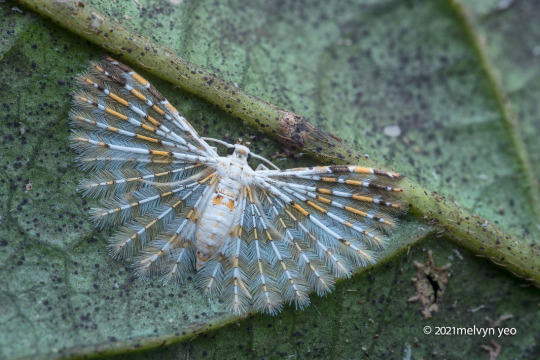
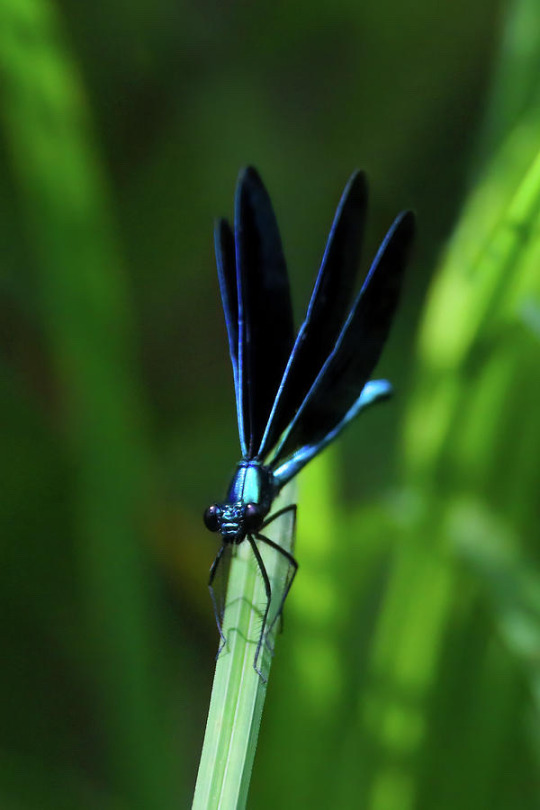
(Sources - 1, 2, 3, 4)
Our last athropods, the hexapod crustacean class Insecta, is one of the most successful groups of animal on earth. They are the most diverse, with over a million known species, comprising more than half of all eukaryote (animals, plants, fungi, etc) species, making them the “Default Animal.” They are comprised of three main groups: Archaeognatha (“Jumping Bristletails”), Zygentoma (“Silverfish” and “Firebrats”), and Pterygota (winged or secondarily wingless insects).
As hexapods, insects have a three-part body plan: head, thorax with 6 legs, and abdomen. They have compound eyes (some in addition to ocelli) and a pair of antennae. Many groups have 1-2 pairs of wings as adults. Insects have many means of perceiving the world: compound eyes and ocelli for seeing, tympanal organs for hearing, and receptors on the antennae and mouthparts for smelling. They live in almost every environment and occupy almost every niche. Many are aquatic, or have aquatic larvae. They are the first animals to have evolved flight. Some are solitary, some are social, some live in large, well-organized colonies. Some communicate with pheromones, some with sounds, some with bioluminescence. Some are venomous, some are poisonous. Most insects hatch from eggs, though some are birthed live. Some hatch as miniature adults, some go through a partial metamorphosis in which the larval stage looks vastly different from the adults, and some go through a complete metamorphosis in which a nearly immobile pupa is formed. Some insects provide maternal care. Some are carnivores, some herbivores, some omnivores, some parasites. Some spend most of their lives in their larval stage, and don’t even feed as adults. Due to the high diversity of insects, it would be impossible for me to summarize them further!
Fossil insects are known from the Paleozoic Era, during which they achieved large sizes, such as the giant dragonfly-like Meganeuropsis permiana, with an estimated wingspan of up to 710 millimetres (28 in), and a body length from head to tail of almost 430 millimetres (17 in).

Propaganda under the cut:
Insects are absolutely critical in all ecosystems, forming the base of the food chain, turning and aerating soil, controlling pests, encouraging or controlling the growth of plants, scavenging and recycling biological materials, and creating topsoil. Without insects, our planet would die.
There are many contenders for “largest insect.” The Giant Stick Insect (Phobaeticus serratipes) is the longest insect in the world, with specimens recorded at over 56 cm (22 inches), including their legs. The Giant Weta (Deinacrida heteracantha) is the heaviest, with a record of 2.5 ounces. Queen Alexandra’s Birdwing (Ornithoptera alexandrae) has the largest wingspan, which reaches up to 30 cm (1 foot) wide.
Meanwhile, the smallest known adult insect is a parasitic wasp, Dicopomorpha echmepterygis, commonly called “Fairyflies”. Males are wingless, blind and measure only 0.127 mm long.
Many insects are popular pets, including various species of mantis, cockroach, beetle, moth, and ant! Some are even domesticated, including silk moths and honeybees.
Many insects are eaten by humans, and farming insects for food is considered more sustainable than farming large chordates. These farmed arthropods are referred to as “minilivestock.”
Shellac is a resin secreted by the female Lac Bug (Kerria lacca) on trees in the forests of India and Thailand. It is used as a brush-on colorant, food glaze, natural primer, sanding sealant, tannin-blocker, odour-blocker, stain, and high-gloss varnish. It was once used in electrical applications as an insulator, and was used to make phonograph and gramophone records until it was replaced by vinyl.
One of the biggest ecosystem services insects provide for humans is pollination. Crops where pollinator insects are essential include brazil nuts, cocoa beans, and fruits including kiwi, melons, and pumpkins. Crops where pollinator insects provide 40-90% of pollination include avocados, nuts like cashews and almonds, and fruits like apples, apricots, blueberries, cherries, mangoes, peaches, plums, pears, and raspberries. In crops where pollinators are not essential they still increase production and yield. Important pollinators include bees, flies, wasps, butterflies, and moths.
Many insects are sacred to humans. In Ancient Egypt, scarab beetles were used in art, religious ceremonies, and funerary practices, and were represented by the god Khepri. Bees supposedly grew from the tears of the sun god Ra, spilled across the desert sand. The Kalahari Desert's San People tell of a legendary hero, Mantis, who asked a bee to guide him to find the purpose of life. When the bee became weary from their search, he left the mantis on a floating flower, and planted a seed within him before passing from his exhaustion. The first human was born from this seed. Dragonflies symbolize pure water in Navajo tradition. In an Ancient Greek hymn, Eos, the goddess of the dawn, requests of Zeus to let her lover Tithonus live forever as an immortal. Tithonus became immortal, but not ageless, and eventually became so small, old, and shriveled that he turned into the first cicada. Another hymn sings of the Thriae, a trinity of Aegean bee nymphs. Native Athenians wore golden grasshopper brooches to symbolize that they were of pure, Athenian lineage. In an Ancient Sumerian poem, a fly helps the goddess Inanna when her husband Dumuzid is being chased by galla demons. In Japanese culture, butterflies carry many meanings, from being the souls of humans to symbols of youth to guides into the afterlife. Ancient Romans also believed that butterflies were the souls of the dead. Some of the Nagas of Manipur claim ancestry from a butterfly. Many cultures use the butterfly as a symbol of rebirth. And the list goes on…
#sorry I had to copy paste some propaganda from the Arthropoda poll I’m tired and it’s A Lot#anyway Chordata tomorrow!#round 2#arthropoda#animal polls#insecta
83 notes
·
View notes
Text
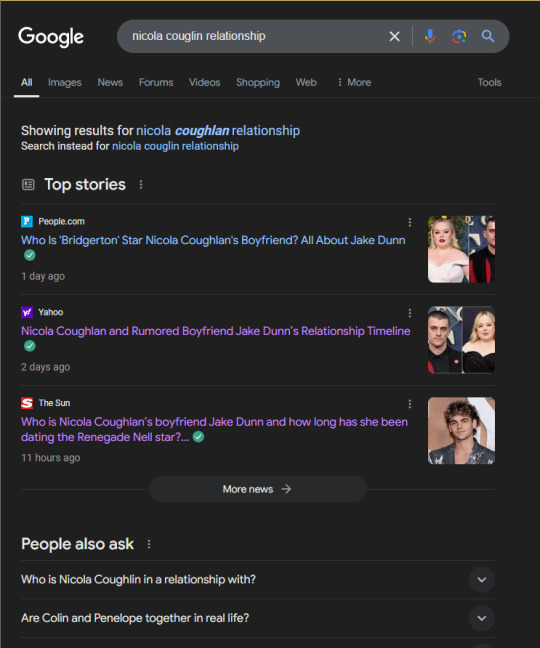
do you believe everything the media and photographs tell you to believe?
if so, this is a post that isn't for you.
[also, I went with the autocomplete in the image, which is why Nicola's name is spelled incorrectly in the search, jsyk]
I wanted to call out that the first three top stories links on Google have Nicola Coughlan linked to Jake Dunn. Each link is to a news source that has no credible source to rely on. Terms such as "rumored"; "seem to confirm" and "believed to be" are used. One of the stories claims to have reached out to Nicola's and Jake's teams for comment, but there's no mention of any responses.
I think it's interesting to note that while the first paragraph or so of each of these articles summarize what's been photographed of Jake and Nicola – which I would argue are moments between friends, much like her interactions with Luke Thompson, Jack Rooke, and Mark Peacock – but aren't able to state anything more in the articles. The articles then diverge into information and previously quoted material from Coughlan about her relationship with who? Luke Newton. Because that's the only relationship she's ever openly spoken about to media sources.
We can continue to split microscopic hairs, but Nicola has never directly answered the question of whether she's solely friends with Luke Newton. She cleverly walks around the question, in the hopes that many will just assume she's friends and nothing more. Which is what a lot of people are doing. And that's their prerogative to do so.
In doing further reading about PR practices, I ran across a post from The Chi Group that discussed a couple of ways that public figures work to combat misinformation about them without making explicit statements:
"Pinning Corrective Posts: Pinning a correction or accurate update to the top of a social media profile can ensure that followers see the correct information first."
Okay, so what does Nicola have pinned to her Instagram post? Her own achievements in the media spheres as of late, where she noticeably mentions Luke Newton, even when it isn't within an ideal context to do so. And as always, the Bridgerton Season 3 promo post. Nothing about relationships or anything hinting to a connection with Jake Dunn.
"Search engine optimization (SEO) is a powerful tool in ensuring that accurate information surfaces in search results, rather than misleading or false content. PR professionals can optimize their content by:
Using Relevant Keywords: Including keywords that users might search when looking for information on a topic can help ensure that accurate content appears in search results.
Publishing on Authoritative Websites: Contributing articles or guest blogs to reputable sites can boost the visibility and credibility of the accurate narrative.
Regularly Updating Content: Keeping web pages updated with the latest information ensures that search engines recognize the content as current and relevant, helping it rank higher."
So the SEO is pushing Jake and Nicola together here in regards to relationship searching, and where Luke Newton has scrubbed SEO information linking him to Antonia, Nicola hasn't done that. I don't think she feels the need when, as stated above, the articles can't seem to gather much about her and Jake Dunn in the first place and revert back to talking about her 'gorgeous' relationship with Luke Newton.
Re: publishing on authoratative websites. The first three sources are from People Magazine, Yahoo reposting an article from Glamour, and The Sun. I certainly don't turn to these outlets for authoritative news, and I hope you don't either.
Re: regularly updating content. Can you point me in the direction of any content published by Nicola Coughlan's social media accounts that provides the latest information about her and Jake Dunn?
I rest my case.
57 notes
·
View notes
Text

my ultimate takeaway from this essay (published 2006) is that it does accurately capture how most viewers respond to sam vs dean as well as sam’s original function as the audience surrogate btwn the two brothers, but it isn’t critical enough of the show’s values - to be fair, expected for the time - and thus does not question whether its characterizations of sam as “bitchy” and “selfish” (in comparison to dean, as always) hold merit at all. it is simultaneously far too accepting of dean’s facade as something purely Aspirational for everyone in the audience.

again, to be fair to the author, this piece was written after only one season of the show had aired, but even as early on as s1 - before dean had absorbed john’s patriarchal role - there were cracks in dean’s larger-than-life facade that the same viewers he consistently distracts from sam with his Dazzlingly Masculine edge dramatically overemphasize to be able to justify their attribution of every “relatable” trait that sam demonstrates much more clearly and intentionally than dean to dean alone, as if the core contrasts between these two characters don’t affect everything about the show. I don’t think it’s accurate to claim that it’s as simple as dean is who we want to be and sam is who we really are. this assumption relies on a usually-subconscious reading of most surface-level dean traits as “good” (strong, manly) and most surface-level sam traits as “bad” (weak, girly). in fact for me personally sam is who I’ve always wanted so dearly to be but I see more of myself in dean than I would like, which makes me very sad as I am unable to gloss over the reality of dean as a monumentally flawed character who does immense damage to himself and others from his uncontested position of authority. if you view the (abuse-enabling) family structure as fundamentally good and surpassing all other forms of human connection, of course you’ll agree with dean/john and (to a lesser but still noticeable extent) the show’s writers that sam was selfish to “walk away” from it in pursuit of a life on his own terms, as opposed to seeing him as I did when I was a miserable teenager as incredibly brave and aspirational for having done so.

I’ll give them this too: the show IS to the bitter(sweet to some) end ultimately about the burden of being “sammy”; to the discerning viewer this never stopped being the case even when the writers finally let their idealization of dean’s facade lull them into swapping him into the Main Character seat in sam’s place, to the overall detriment of the story… although from what I’ve seen no dean-biased viewer would be able to point to this switch as being responsible for the lack of focus and confused emotional beats of the late seasons. the expansion of dean’s role in tandem with the shrinking of sam’s is absolutely beautiful horror for fanartists willing/able to transform the source material with an understanding of why those original surface-level dean traits were only ever amplified over time whereas the definitive surface-level sam traits that primarily existed to further idealize dean’s facade were steadily chipped away at to the point that the audience discusses “bitchy sam” as if he is a relic of the early seasons, and otherwise tends to dismiss the final canon iterations of him as so gentle and toothless as to be “boring.” mind you, this is the same audience that was numbly swayed by the narrative into believing that sam’s anger (suspicious) was a character defect while dean’s anger (righteous) was an asset, and the same audience that carried their narrative-supplied/dean-supplied idea of sam as “selfish” into the last season of the show (s8) that portrayed him pushing back against his restrictive role as “sammy.” every version of sam was doomed to inadequacy for the majority of this audience, because of sam and dean’s respective roles.
TL;DR I wish this shit was easier to summarize so you’d know why I disagree with almost everyone who comments on this show <3
#the audience versus sam and dean#research hole#wrote this up instead of sleeping or anxiously ruminating 🥴#also: even for me this essay was WAY too heavy on the parentheticals lmfaooo#like just unnecessary after the establishing paragraphs#archive later
25 notes
·
View notes
Note
I would love to hear your opinions about ancient currency! And any recommendations you have for learning more about the Roman economy!
oh boy i am SO glad you asked! I'm going to put everything under a readmore because it's a Lot.
I have a few opinions on Greek coinage, specifically that of the introduction of coinage to Athens, though I'm working on a proposal for studying Spartan coinage rn.
Current publications re:Athens haven't really determined For Sure who introduced coins; it's a toss-up between Solon and Pisistratus but I'm in the Pisistratus camp for reasons that I can absolutely summarize in a separate post, as I've written and published a paper in my undergrad journal that (hopefully) holds weight in the current hodgepodge of thoughts. If you'd like that, I can write it up and link it here!
Re:Spartan coinage, I think the Spartan homoioi were real idiots. Most city-states were using silver (and very occasionally gold) for their coins, but Spartan homoioi were using iron spits. The spits (obeloi) were six to a drachma, which was the exchange rate for a long time. And by long time I mean there was no such thing as a floating conversion, coins were just the most portable form of precious metal, which was intrinsically valued. Outside Sparta (even the perioikoi) most city-states would have used ingots pre-coinage and that evolved into stamped metal, i.e. coinage. The Spartans considered themselves to be very religious and followed the Great Rhetra (unsure if Lykourgos existed), which maintained that silver and gold were holy and could not be used, so they used iron.
Unfortunately, the rest of Greece didn't follow that, and used silver in their coins, especially influenced by Attic-Ionian city-states who were in regular trade with Persia and further east, i.e. regions that valued precious metal outside their religious significance. Essentially, Spartans kinda screwed themselves over re:trade outside Sparta; they couldn't even trade in contemporary currency with the rest of Lakonia and forced their subject city-states into the same position. This is supported mostly by the explosion of Messenian and other Lakonian coinages after Sparta collapsed, though I want to see if I can find more text evidence, since I (an archaeologist) tend to rely too heavily on material. It's a whole thing, personally I believe this was a significant factor in Sparta's collapse, though other things factored in as well. Sparta was incredibly insular both in its trade/economy and religious practice and that combination led to its downfall.
For the Roman sources, I recommend starting with the Cambridge Companion to the Roman Economy by Walter Scheidel, and The Ancient Economy by Walter Scheidel and Sitta von Reden. Von Reden has excellent articles related to the ancient economy in general, and most are available on JSTOR, so I recommend giving her stuff a look.
I also highly recommend reading Moses Finley's work The Ancient Economy (no relation to Scheidel and Von Reden's work), as it lays the foundation for much of our current school of thought. Peter Temin's subsequent work, The Roman Market Economy argues against Finley and kicks off a whole debate about how to define an economy without using capitalism as the basis, because capitalism as we know and define it did not exist then, and it is incorrect to assume that. We can call it protocapitalist, but not capitalist.
Slavery in Rome is a nuanced subject that is integral to learning about its economy — I suggest keeping an open mind and treading carefully with respect to post-1492 slave trades. Noel Lenski's chapter "Framing the Question" (linked; you need access through your institution) discusses the slave trade against a Finleyan model, while Scheidel (him again) talks about how to determine the wages of slaves (JSTOR link). W. V. Harris talks about the demography and geography of slaves here (JSTOR link). These three are good starts for learning about Roman slavery, but if you want more sources, I can pull some up for you.
I don't want to overload you with sources, so in general I'll recommend anything by Scheidel, Von Reden, Nicholas Purcell and Peregrine Horden (connectivity), Seth Bernard (coins and emissions), Astrid Van Oyen (tech innovation), and Willem Jongman (economic structure). As with the slavery sources, if you want direct links I can definitely find them for you! I'm always happy to share info :)
71 notes
·
View notes
Text
I was sent this by @metamatar on my thread about the material reasons why the US is not materially incentivized to back Israel. I'll be honest - I do not find it very convincing. Let's dive in.
The recent period has seen the bloom of two falsehoods, stemming from the same root of irrationality, glibly ahistorical narratives, and disinterest in understanding struggles for national liberation against imperialism. One: Benjamin Netanyahu more-or-less conspired with Hamas to maintain the Palestinian national division and empowered the movement in Gaza. Two: Israel and its parasitic lobby drive America into irrational warmongering.
The first is a slight overstatement of my position - there is no conspiracy, merely shared interests. The second is very far from my position - the US needs no external sources to drive it into irrational warmongering, but in this specific case, domestic support for Israel (both popular and elite) is what drives US support.
The ‘Netanyahu courted Hamas’ fairy-tale is newer, an odd chimera of the older truth that Israel and the US preferred Hamas – but, seldom mentioned, also Fatah – to Marxist-led Palestinian forces in the 1980s, and the newer truth that Netanyahu made deals that had allowed Hamas some financial manoeuvring space since 2014.
I think this basically concedes to my position on the first "falsehood," though it fails to mention Netanyahu's statements arguing that Hamas was a bulwark against Palestinian statehood.
From here on, the article spends several paragraphs summarizing the history of the Israeli-US relationship. While riveting, this does not directly relate to the question of US interests in this current war, so we'll skip ahead a bit.
The ‘Netanyahu enabled Hamas’ distortion rests on the correct statement that Netanyahu dealt indirectly with Hamas via Qatar and allowed the formation of a permit regime for Palestinian Gaza guest workers. This was meant to ensure relative quiet in the South. Far from Hamas collaborating with Netanyahu, or policing the ceasefire, this set-up was an achievement of the Palestinian resistance, allowing it the appearance of political stillness on its surface waters while underneath it moved fast and built up a deep defensive infrastructure. The lie is meant to suggest that Hamas’ strength is due to conspiracy with Israel, when Hamas simply expresses the nationalist aspirations of the Palestinian people.
This is another, further distortion of the argument being made in "falsehood" one - that Israel's interests were served by Hamas. The idea that Hamas' strength emerges from conspiracy with Israel is absurd. It is, however, true that Israel has been willing to bolster Hamas and prefers it to a unified Palestine under the PA. Speaking of which:
This tall tale has also suggested that Netanyahu wished to avoid direct talks with the PA in Ramallah towards a peace agreement. The lie is the implication that the neo-colonial PA is a force for state building and Palestinian sovereignty. In fact, it is the velvet – more often these days, mailed – gauntlet of neo-colonial collaboration in the West Bank, amidst PA coordination with Israel and the murder of anti-collaborationist cadre like Nizar Banat in 2021.
This is, imo, completely correct - the PA is collaborationist. What this misses is that modern Israeli maximalists like Netanyahu reject the line pursued by the US, that of a collaborationist state governed by the PA. Even this shell of a state, along the lines of what was offered during the prior peace process, is now outside the bounds of what the ultranationalist Israeli far right is willing to accept.
Amidst closure and de-development, the popular resistance has been able to consolidate an arsenal and bring 1.5% of its population into a guerrilla force of 30,000-40,000 men that can – man for man – outmatch nearly any in the world.
This is where the article starts to go off the rails a bit. Can Hamas, man to man, outmatch nearly any army in the world? How would we know? Does this read like someone trying to do analysis or trying to write a PR piece?
The concrete is their mountains. From there they have imperiled an enemy with orders of magnitude higher GDP per capita – Israeli GDP is at $52,000 a year, with arsenals worth billions.
Fifth, through these achievements, the Palestinian resistance has been able to present an acute threat to the settler-capitalist property structures called Israel,
Here, we continue into mythmaking. How has Israel been imperiled? What acute threat has been presented? Certainly, over a thousand people were killed, but this does not constitute a threat to a nationstate. The article does not attempt to justify these statements further.
It is unimaginable that the neocolonial authoritarian states nor their US benefactor would remotely tolerate massive working-class militia which speak a language of justice and republicanism and raise arms against those states’ sponsors. In turn, it is as natural as the sun rising in the East that the US, the UK, Germany, France, and their Gulf and Arab satraps would converge on support for Israel as the spear’s tip of the assault on the surrounding Arab popular militia.
Much of the "analysis" in this article takes this form - broad, sweeping statements with little attempt at justification.
Interestingly enough, this article actually links a far more lucid and well-reasoned analysis of the situation, with this funny aside:
(When did Marxists decide it is their job to whisper to the exterminationist class that their calculus is off?)
Good analysis is its own reward!
This article contains sentences like this one:
To contemplate any real reduction in its presence, though, it first needs a security settlement that would strengthen friendly regimes and constrain the influence of nonconforming ones. The 2020 Abraham Accords advanced this agenda, as Bahrain and the UAE, by agreeing to normalize relations with Israel, joined a wider ‘reactionary axis’ spanning the Saudi Kingdom and Egyptian autocracy. Trump expanded arms sales to these states and cultivated connections between them – military, commercial, diplomatic – with the aim of creating a reliable phalanx of allies who would tilt towards the US in the New Cold War while acting as a bulwark against Iran.
Which was really a breath of fresh air after the previous article. Directly citing US policy from the last ten years - incredible!
While it would be flattening a very nuanced article to claim that it takes my point of view, this is one of its core arguments:
Second, in pinning its imperial strategy on the Israeli normalization process, the US became especially reliant on this settler-colonial project just before it was captured by its most extreme and volatile elements: Smotrich, Ben-Gvir, Galant. If American support for Israel has historically exceeded any reasonable political calculus, under Trump and Biden it acquired a coherent rationale: to place its ally at the centre of a stable Middle Eastern security framework. Yet the Israeli cabinet that came to power in 2022 – addled by eliminationist fantasies, and determined to draw the US into war with Iran – proved least able to play that role.
It makes the argument that recent US support for Israel was part of a larger strategy to disengage from the region, but one that made mistaken assumptions about the ability of Israel to maintain stability, and that the eliminationist actions of the Israeli state have undermined the realpolitik rationale for US support.
I am not going to go through the second article because it would mostly consist of me nodding along, but I think we see two distinct ways in which leftists write on display here.
The first article makes very broad assumptions about US goals and motivations and cites actual events only sparingly and selectively to support its thesis. The second puts the focus on the events themselves and draws out the motivations from them. The former is useful for writing fluff for people who are already convinced of your point of view, but it does not pass very convincingly for analysis. The latter reads like someone who is actually trying to understand the world.
84 notes
·
View notes
Text
Stella: A Collection of Articulated Yappings Pre-Season 3
Aaand she's all finished. Yay 💜 And since neither ao3 nor tumblr won in the poll I made for it, in the end I decided that it shall here too
Chapter 0.9: Introduction
Greetings! I wanted all my thoughts on Stella to be nice and pretty and orderly SOMEWHERE, and what better time to organize them than while in waiting limbo.
I want to preface this by saying one thing. Two things, actually.
1) My “base” are a bunch of posts that I wrote on my blog over the past months, and that I wrangled into an essay-ish style and divided into small sections to fit a chapter-by-chapter format. Part of the reason I chose to do this was because the further time went on, the madder I got with… some things… and I didn't want to carry that energy over to this experiment.
2) I am not part of the self-identified “critical community”, as in my experience it's a crowd of people who either stick around just to hate on the story despite disliking its direction or who misuse the word “critical”, interpret characters' actions/behaviours through the worst lenses possible, and use said misreadings of the source material to make up reasons to hate on the story, on the people who work on it, etc. That being said, I have some issues with the broader fandom as well when it comes to how people talk about Stella, and some of those grievances will come up here. I am also not going to preface every paragraph with reminders that Stella is a bad person or things along these lines: I shouldn't have to lead people by the hand.
PS. Because the images embedded in this chapter were made some time ago, they have that passive-aggressive vibe that I want to avoid here. Despite this, they summarize my points well enough, so I chose to include them anyway.
Chapter 1: A Full Barrel And A Drunk Wife
Title reference: the Italian equivalent of having your cake and eating it too. Both at the same time = ❌️ !

“Why can’t villains just be evil anymore? Why must we care for their backstory, motivation, interiority?”
These are frequent questions when it comes to media discussions, and many a time the answer is a simple one: because stories which can afford one-dimensional villains are few, and stories which deal with mature themes are generally not amongst them. Monodimensional villains work best when the narrative that they belong to engages in simple, “black vs white” morality (as is often the case in children's stories), in the context of certain kinds of fantasy or horror media (where they can embody specific concepts, fears, elements), et cetera. When a show that doesn't share these traits approaches its main characters and their struggles with nuance, it sets up the expectation that surely this treatment will be expanded to their conflicts against their respective antagonists. By refusing to develop its villains, it thus runs the risk of trivializing the very conflicts that drive its story. In this case, a villain with no depth is not a good contrasting force to a complex protagonist: the stakes are too unbalanced. Furthermore, a villain doesn't need complexity for the purpose of becoming sympathetic— or redeemable, as many often say (accuse): it’s for making them believable. If a character’s motivations are rooted in reality or even just feel realistic, refusing to engage with them weakens the narrative. If I can have an easy understanding of what could lead a person into a downward spiral, then that automatically absolves them from being “just evil”.

In light of being so invested in its protagonists' inner world and complexities, and in the way their circumstances affect every aspect of their lives, Helluva Boss is one of those shows which cannot afford to neglect most of its antagonists, because doing so would undermine the very narrative that it's trying to build. Stella is one of these antagonists. By having committed to exploring Stolas' struggles, allowing Stella to remain a one-note villain would weaken the overall story due to the fact that the two of them not only came from the same background, but also share significant history with each other (three characters if we count Octavia as well). The story has already “gone there” with one of them, so why shouldn’t it do the same with the other one, when it would only make for a better, more complex depiction of an emotional reality?
Once again, the issue isn’t that Stella is a bad person. It’s that there's been no effort put into her characterization, and “you will see her backstory soon” can only carry you so far when she’s been stagnant for two whole seasons. It feels lazy, mismanaged at best, and it's made all the more glaring by her narrative proximity to Stolas. All she's done so far is function like a plot device.

There are viewers who are actively hostile to the idea of Stella becoming a complex character — or rather, having inherent complexities which need to be addressed — which is why I sympathize with her “stans” to a point, because oftentimes discussing her leads to receiving backlash regardless of the opinions expressed. I said “to a point” for good reason: these are the same people who accuse the writers of babying Stolas, who outright victim-blame him, and so on. I share their frustration and dissatisfaction with the handling of Stella's character, not what they blame them on.
Chapter 2: That's The Last Song You'll Ever Sing
Title reference: Bird Song by Florence + the Machine.
S2Ep1: The Circus foregoes all subtlety by very explicitly unveiling a theme that will recur throughout the whole season, and that had been floating in the background of the show since its very beginning: childhood experiences, and their clear and undeniable effect on a person's development. While the episode doesn't remotely focus on Stella's perspective, as neither do S1 and S2 as a whole, I believe that her picture offers some insight into her childhood— whether any thought was actually put into its contents and despite the fact that many took it as proof that she's innately evil.

Violence does not exist in a vacuum, especially when it comes to children. While the specifics of Stella’s situation are still unknown, one can speculate.
As seen with Stolas, children of the aristocracy are burdened by strict expectations, and their value is tied to their usefulness to their family: they are assets with no freedom or autonomy. Stepping out of line or not being able to live up to the family's expectations equals punishment, physical and emotional. Even accounting for how spoiled Stella would have been growing up, this would apply tenfold to someone whose duty will be to marry a prince and provide him with an heir. Stella’s naivety as an adult is another point of interest: aiding or encouraging her psychological and emotional development clearly was not one of the objectives of her education. And why should it have been? What a waste of time, effort, and resources for someone whose destiny was to just be a prince's bride and the mistress of a palace, with infinite material wealth to appease her every whim.
Cruelty — cruelty towards animals especially — can be born from feelings of powerlessness, frustration, fear or uncertainty even, as a drastic attempt to feel the slightest bit in control. If Stella was raised in a strict or outright abusive environment, which the Goetia family inherently is, it would make sense for her behaviour to be a misplaced reaction to her circumstances.
Saying that Stella was simply “born bad” is an easy, maybe tempting explanation because it doesn’t require any reflection, nor any openness towards her. Stella has been a one-dimensional villain for the entirety of two seasons so far, but for the sake of the show's credibility, she can't remain one. She's an unexplored character, but there's no need to look too far for ways to dive into her interiority, as there are many options to explore even just by using this small glimpse of her childhood as a guideline.
Chapter 3: Everything Will Glow For You
Title reference: The Love Club by Lorde.
Personal traumas aside— while class and species differences have been the underlying causes for the conflicts within Helluva Boss thus far, the Goetia family embodies a kind of structured power which further complicates things from a social point of view.

[Note: this image was made on a whim to summarize as much as possible the contents of a post. As such, it is extremely reductive.]
Historically, especially in the aristocracy, marriage has been a contract between families and a means of securing alliances and reinforcing societal hierarchies. Within this system, women are tools for dynastic continuity and defined by their relationship to the men around them. The information at our disposal makes it clear that the Goetia family is structured in such a way that it upholds these patriarchal traditions, ones which abhor the idea of transgression. In such a context, for example, the scandal of Stolas' affair with Blitz is twofold: Blitz is ontologically other and lesser than, and Stolas is rejecting the expectations placed upon him by a system that both disdains and feels entitled to his person. Similarly, the Goetia family’s broader values place emphasis on the intersection of traditional masculinity and power. The notion that a man must be virile is tied to misogynistic and homophobic ideals: failing to meet certain expectations leads to derision and ostracism, which in turn reinforce the idea of femininity being inferior.

Whether Helluva Boss wants to engage with such underlying social dynamics or not, their implications are embedded in its narrative by virtue of the subjects it chose to depict: its characters must navigate a rigidly hierarchical world, and at least within the Goetia family that hierarchy is also patriarchal in its expression. In this sense, while the show may not consciously frame Stella's scorn for Stolas' deviation from traditional masculinity through homophobic or misogynistic lenses — she never comments on Stolas' sexuality itself or on Blitz’s gender, after all — the fact remains that it's a challenge to the fundamental ideals that make up her worldview.
Stolas' decision to pursue a divorce is another such challenge.

Once again: marriage is a contract. In the case of Stolas and Stella's marriage, he secured Paimon's lineage by having an heir, she presumably secured her family’s standing, as well as her own. In light of this, Stella’s reaction to Stolas’ affair cannot be dismissed by just saying that she considers imps to be inferior to goetic demons, or to other hellborns. She absolutely does, mind you. But Stella is also a character who's profoundly concerned with self-image and reputation, and this concern reflects a broader societal pressure: as a noble and a woman, her worth is intrinsically tied to the image of marriage and monogamy. Even more crucially, divorce in the Goetia family isn't just scandalous and reputation-damaging, it's also never been done before— or so Andrealphus alleges in S2E4: Western Energy, at least. So Stella rages, because Stolas' affair, who his lover is, and their divorce are all compounding forces which undermine the very foundation upon which her authority stands.
I have no interest in trying to convince people to feel sympathy for Stella. However, I am interested in pointing out the forms of societal oppression that have shaped her life, and that are implied in the fabric of Helluva Boss' narrative— regardless of whether the show will ever choose to directly acknowledge them or not.
Chapter 4: Coal To Diamonds, Sold To Fools
Title reference: The Family Jewels by Marina.
The first private interaction between Stella and Andrealphus that the viewers are privy to is deliberately unsettling, for the show consciously employs seductive tension on Andrealphus' part to imply that there's an incestuous aspect to their rapport: Andrealphus doesn't simply repeatedly comment on Stella's beauty and calls her by sexual appellatives, he also invades her space and physically touches her when asserting his dominance over her.



While Helluva Boss ultimately chooses not to pursue this path, it purposefully framed their introductory scene in such a way that it would have benefitted from the expectations and suspense set up by media with similar characters which preceded it, and which did cross that line.
The nature of abuse is insidious, and the dynamic between Stella and Andrealphus displays this well. At its core is power, something which Andrealphus holds over Stella in a way that shapes their entire relationship. Abuse also transcends sexual orientation, which is why his sexuality doesn't negate nor collide with incestuous readings of his behaviour towards her — however sublimated said incest actually is — and the structure of the Goetia family itself, which is patriarchal in nature, legitimizes them to a point: such dynamics aren't deviant, they're an exacerbation of the power imbalances which are inherent to the institution of the family.
The insults to Stella’s intelligence and the physical objectification which follow them aren't mere jabs, they're a means through which Andrealphus manipulates her into being — or remaining — dependent on him. In this light, an interesting detail to note is the way in which Stella’s thoughts immediately go to him after Stolas pushes on getting the divorce, coupled with the fact that he does step in to manage its proceedings. They're proof of how ingrained his influence over her is.
Stella constantly gets reminded that her worth is contingent on the prospect that she can be used by others. Her family first and foremost taught her that, and Andrealphus keeps reinforcing this belief to this day. It makes all the more sense, then, for her to be vulnerable to manipulation and paternalism, but capable of verbally standing her ground in an outright conflict.

She doesn't retaliate with a magical display of her own when Andrealphus aggressively tries to confront her — she maybe can't — but neither is she scared of him. One might wonder if the idea of being in danger is just as foreign to her as it used to be for Stolas, rather than naivety or trust that her brother wouldn't genuinely try to hurt her.
The different ways in which Stella and Andrealphus pursue their objectives, as well as what they're respectively after, also speak to their upbringing. Stella's childishness makes her impulsive, hedonistic in the sense that she seeks immediate gratification for her wants: maintaining her social image and destroying everything which threatens it. She's not a strategist, but neither was she ever educated to be one. By contrast, Andrealphus is calculated and power-hungry, but his arrogance blinds him to the way in which his plans aren't nearly as clever as he thinks they are. For example, in S2E4: Western Energy he makes a show of belittling Stella for not caring to capitalize on her divorce from Stolas, but he had nothing to offer her other than vague words about waiting for future options and opportunities. He stalled, as he would have kept stalling if it hadn't been for Stella mentioning Stolas and Blitz's deal in S2E11: Sinsmas. The reason for this is clear: because Stella can be so easily swayed, his objectives take precedence over hers—metaphorically and literally, seeing his relevance to the show's second season finale.
Being nobles, both Stella and Andrealphus are accustomed to power and privilege. Andrealphus is manipulative as a means of maintaining the status quo, and his actions show that he feels entitled to dominate those around him. Stella, likewise, is used to power and control, and her desire for revenge against Stolas is rooted in her need to preserve the stability of her own social image. This shared noble background explains why they both resort to abuse and control to achieve their aims, as they would have learnt to see others as tools from a young age. The difference between them is that Stella finds herself in both roles: a tool to her family since birth, a handler for the first time upon being matched with someone whom she could leverage her power over.
Another thing to note is how their difference in rank doesn't seem to play a part in their personal dynamic. The familiarity between them certainly allows them to be comfortable with each other, but it is interesting that there doesn't seem to be an underlying power play between them in this sense as well— so far, at least.
Chapter 5: Lovely Ladies, Maids of Honor
Title reference: This Hurst by Mindless Self Indulgence.
As previously stated, Stella was raised in a specific environment, one which would have dictated her role, her relationships, and the manner in which she was to navigate private, familial, and marital affairs. She would have been conditioned to expect a number of things too, like a husband who fit a particular mould, interactions that followed strict social codes, and a life that adhered to a multigenerational, ever-repeated script. The quality of these expectations is irrelevant: they were foundational to her sense of self and prospects. I do believe that marrying Stolas, who doesn't align with these expectations and doesn't embody the ideal image of a goetic prince, was profoundly destabilizing for her.
However unappealing the things she was groomed to wait for may have been, or even if she accepted them without question, they still were a certainty, they were something which she was prepared for. It feels accurate that someone like Stella wouldn't react to this sudden freedom with delight, but resentment— and disdain when it comes to Stolas' inability to play the game, so to say. Although there probably also was a perverse kind of relief beneath it all: she wasn't just a victim of her circumstances anymore — whether she ever saw or consciously acknowledged herself as one or not — but also an agent within them, as well as a beneficiary of them.
Stolas is of higher status than Stella, but he's socially weaker than her: he's meek and solitary, seemingly unfit of his role as prince, hardly a man even in her and her friends' eyes. This is what allows her to have leverage over him, because she revels in her role— or so it’s seemed so far, at least. Her actions must be understood as her way of lashing out and establishing control in the only way she knows how: through cruelty, just like when she was a child.
This is a feature of the Goetia family and institutions like it, not a bug: people recreate the same cycles of violence that they experienced in their lives, and they become enforcers of the system if they feel that they benefit from it, regardless of the damage that that same system may have caused them.
Regardless of what leads Stella to be abusive towards Stolas, ideas such as that she should have been “grateful” for having been married off to him, of all people, is a deeply insensitive perspective. It doesn't matter that Stolas is gay and good at heart, it doesn't matter that they could have been allies if she had just been willing to open herself up to him, not if the ultimate goal isn't to point out just how deeply harmful and insidious the Goetia family and its convictions are, because such a view insinuates that the mere absence of violence should be enough to appease someone. It downplays the psychological and emotional toll of lack of agency and coercion, and it doesn't account for how systems of oppression operate.
Chapter 6: All The Way To The Chapel
Title reference: Family Tree by Ethel Cain.
Stolas' fears of being a monster and tormentor to Blitz are a reflection of his lived experience, but I don't believe that he directly equates his situation with Blitz to his marriage with Stella in the way most people think. Someone did have full control over the course of his life, but that person was not Stella: a close look reveals his father; a farther look, the way in which the Goetia family functions as a whole.
Stella and Stolas' marriage is shaped not only by direct, interpersonal abuse, but also by their position within a rigid social network with rules and expectations that affect them both. Stolas' way of coping with these circumstances was by retreating inward, choosing passivity to both bear with his situation and for the sake of Octavia. By contrast, Stella violently externalizes her feelings, which led her to be physically and verbally abusive toward Stolas for not embodying her mental image of how a Goetia should be. Their relationship was one of abuse, but relegating the conversation to just their personal dynamic oversimplifies the broader power structures that are woven in the fabric of Helluva Boss— whether the show recognizes or is willing to acknowledge their presence in more depth or not.
The marriage between them was inherently coercive at the outset, an obligation which stemmed from external societal pressure. Both were expected to fulfil their duties regardless of their wants, and producing an heir was one of these duties.
Arranged marriage is a deprivation of agency, and this very nature makes it so that neither party can ever truly consent to intercourse. This socially and structurally imposed duress, however, does not inherently translate into assault— not in a direct way, as it's often intended.
Stolas and Stella were both under the pressure of having to conform to their roles, and with this context in mind, my impression is that the claim that Stella raped Stolas stems from a desire to victimize him and vilify her beyond the show's actual intention. In a situation which demanded sex for the sake of progeny, a foretold progeny, Stolas' passivity feels like his way of enduring it in a way that allowed him to be as emotionally and physically disengaged from Stella as possible. This makes for a tremendously unhealthy and dysfunctional dynamic, and Stella despises him all the more for it — that's not how a man should act — but rape is an exertion of power and control, as well as an expression of feelings of entitlement to someone else's body, and I object to the belief that Helluva Boss even remotely wants to suggest that something of the sort occurred between them. As I previously mentioned, though, it feels like there's an eagerness to ignore the complexity of Stella and Stolas' circumstances for the purpose of imposing a rigid victim-perpetrator lens to an aspect of their marriage that's entirely out of both their hands, and it partially feels like this is all because some would find it “fitting” that Stella would do such a thing — either by pressuring Stolas or by directly forcing herself on him — since she's altogether emotionally and physically abusive toward him already. It's a stance that somewhat obliquely implies that domestic violence must include sexual assault in order for it to be truly severe, which is an unfortunate consequence of this inclination to aggravate Stella’s cruelty.
I do concur that what she did at their anniversary party was sexual harassment, however I don't believe that her enjoyment of his humiliation in a public context proves in any way that she was similarly foul in private: Stella wields social power over Stolas, she enjoys it, and that was the perfect context for her to elevate her image by undermining his.
Stella's behaviour makes her an aggressor in many ways, but this proclivity to a black or white mentality on a fronts stems from the refusal to acknowledge the complexities which are inherent to their situation. It's troubling for abusive behaviour to be attributed to “someone's nature”, it's troubling for people to deny that abusers do what they do not because they're plainly evil, not because they're shallow, but because they can justify their actions to themselves by following an internal logic that puts them in the right. And it's troubling for people to deny the reality that abusers can be victims too, and that their behaviour does not take away from this fact.
The Goetia family's inner workings ensured that neither Stella nor Stolas had true agency, ever. Stella may be Stolas' direct villain, but the truth remains that once upon a time two children were groomed, and later on two teenagers who'd likely barely stumbled into adulthood had to respond to two families and a king's demands for an heir. Yes, it's awful that a gay boy had to marry and lay with a girl. It's just as awful that said girl had to marry him and have a child with him. It's harrowing, like it's harrowing that the broader systemic forces which made this happen go ignored for the sake of reaching for an interpretation of debatable legitimacy to justify a war on a fictional character in the name of another.
Chapter 7: Nothing In The World Belongs To Me
Title reference: My Love Mine All Mine by Mitski.

This is a limited edition enamel pin from 2021. I apologize for the way it's presented, I wasn't able to find a picture of it in decent quality — shame on me — and thus opted to rely on this edited image. I don't trust merchandise to be a consistently reliable tool for the purpose of character analysis, but I find that this one illustrates part of what I want to argue rather well.
Stella’s hold on Octavia is not that of a loving mother, as she's remarkably presenting her as an object of significance rather than cradling her like a child. There's an angle of pride to such a gesture: Stella's purpose and worth in the family was contingent on her ability to produce an heir, and Octavia’s existence is evidence that she fulfilled her role. Octavia isn't just Stella’s daughter, she's the symbol of her status, and at this point she may even be of greater importance to her than Stolas was. Her husband was disgraceful, an embarrassment who maybe was starting to drag her down as well rather than making her look good by comparison. For how humiliating it was to affront the rest of the family in such a way, divorcing Stolas was possible because Octavia remains— her accomplishment remains. Her daughter is her badge of honour, but also something akin to a shield, an angle which the pin illustrates rather well: holding something in front of oneself is a defensive gesture, and Stella’s face being concealed supports the idea that she wants people to see her for her asset rather than simply see her person. There is also an element of control to such a posture — Via does rather look like a doll in her arms — however, considering the show's direction thus far, I'd hazard the guess that Stella believes to have a claim over her daughter as an object, but not as an individual.
The doubt remains, though: does Stella in any capacity love Octavia, or is her daughter simply a signifier that she's accomplished her role? I don't believe that the current state of her character allows for a certain claim to be made in either direction… However, while I can rationalize why they exist, I do think that there's a fundamental flaw to binary questions of this kind, for their underlying premise is that emotions and feelings have a qualitative component to them, and that love is an inherently positive force. The emotion or feeling of love itself is neither good nor bad, and the way it manifests hinges on spatial and temporal context. Parenthood has always had a component of legacy, ownership, and control to it, and this would be even more accentuated in an aristocratic context: it's the groundwork upon which the institution of the family is built— a fundamental power imbalance. It's the reason abuse is such a common phenomenon in settings of this kind.
Helluva Boss is ultimately a sentimental and sappy show, and while it may never take into account or care to dive in such uncomfortable realities, from an external point of view, I don't think it's incorrect or improper to say that Stella loves what Octavia's presence says about her, and that that in itself can translate into a form of affection towards her person as well, however twisted it may be, as well as self-serving in nature. It's not what anyone would consider a good kind of love, especially from the perspective of a child, but it's better than indifference or revulsion, I suppose, and I'm positive that Stella doesn't feel either of those things for Octavia.
Chapter 8: From Row Point Of View
Title reference: My Heart Still Beats by Maria Mena.
Stella hasn't ever been shown to be caring towards Octavia — there was no time or space for it even if she were capable of such a feat — yet she has never been hostile towards her either, neither directly nor by implication. It hasn't escaped me that the only family portraits in which Stella is smiling are the ones where Octavia isn't a small owlette anymore, and it makes me wonder if she maybe has some aversion towards young children.



While it wouldn't excuse her neglect, which may also be attributed to her noble status and the presumption that childcare is a servant's job, it wouldn't surprise me if she did. Clearly she was little present throughout her childhood — as suggested by her exclusion from Via’s drawings or by the fact that she wouldn't offer her comfort when she asked — but the fact that she brought her along when leaving the house before the divorce and was upset at the thought of Stolas "turning Octavia against her" indicate that she has at least a practical interest in cultivating a tepid relationship with her daughter now that she's older, if an emotionally stunted one. Considering that despite everything Octavia gets upset with Stolas on her behalf as well and is willing to — albeit hesitantly — lean on her for support, she must have done a good enough job at making her daughter... if nothing else, not despise her.
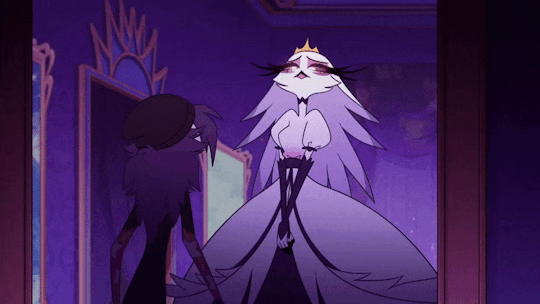

This is why Stella has the potential to start having a bigger influence on Octavia now. Stolas' affair with Blitz found him unable to juggle its consequences, his inner struggles, the changes to his life, his wants, his responsibilities as a father, and so on. Octavia felt a growing sense of alienation from him for a long time before reaching a breaking point, but for however openly violent towards him Stella became, she remained the same towards her: Stella doesn't have an emotional bond with her, but she's never made her feel abandoned either. It's important to also keep in mind that, as far as Octavia knows, Stella is resentful and retaliating against Stolas for having been cheated on, rather than escalating a pre-existing abusive dynamic beyond closed doors. The negative rebound that Stella’s actions have on her is still blatant, but as an emotional complexity it's different to process and grapple with than being privy to long-term domestic violence.
Even though in S2E1: The Circus Stella was ultimately dismissive of Octavia, her words at the anniversary party — "I'm glad one egg fell out of me, [...]" — were a means to not-so-indirectly degrade Stolas, not a deliberate, malicious attempt to objectify or disregard her daughter. Something similar to this happens in S2E12: Sinsmas: "He thinks he's going to talk to his daughter" isn't a freudian slip which betrays a rejection of Octavia on her part, it's a centering of the fact that she's depriving Stolas of the chance to restore his emotional connection with her— and that she's enjoying doing it. Another interesting detail is that in S2E4: Western Energy she wasn't remotely concerned by the thought of Octavia fully inheriting her father's wealth, whereas Andrealphus very pointedly was, and her willingness to follow his follow his plans is based on her eagerness to further damage Stolas, not to prevent Octavia from coming into her birthright.
Ultimately, a conviction that I'm very firm in is that Stella would never purposefully harm Octavia. She'll use her to hurt Stolas, she'll not think twice about letting her get caught up in schemes and manipulations if these benefit her, she'll be inconsiderate of her feelings, but she would never do or allow something to happen to her. Not out of love, but out of self-interest: Octavia is the value by which she is appraised, and she would never stand for her position to be compromised in such a way.
This most prominent aspect of Stella’s character — her concerns with image and status — is particularly interesting, because it creates a curious, seeming contraction when it comes to Octavia.
When talking about parenthood within the Goetia family, one can't not use Paimon as a reference. He exists within the same system of aristocratic expectations and posturing as Stella, but his absence and neglect are much more pronounced than hers. Furthermore, Paimon is an archetypal pater familias: his authority over Stolas was absolute, a signifier that family honour takes precedence over all, and that individual agency is subordinate to the will of its head. As such, Paimon was greatly concerned with Stolas' behaviour and presentation, because they would have reflected on him.

What's interesting about this is that Stella was greatly concerned with Stolas' behaviour and presentation for the same reason as well, yet Octavia seems to have been granted a surprising amount of personal freedom— certainly more than her or Stolas were ever allowed at her age. Much of this is to be attributed to Stolas' involvement in her upbringing, but the reveal remains unchanged: Stella never interfered or tried to influence her daughter's self-expression. That's an interesting choice to make in a context where your child is a projection of your image. Is she maybe willing to let Octavia have her own individuality (like I obliquely alleged in the previous chapter), or is this going to change now that Octavia isn't just Stolas' "precautionary" heir? Each path has much potential to it, and this is pure speculation on my part, but either one could serve as a point of contrast between Stella and Andrealphus in the long run, should the show choose to dwell on the differences between them.
While Stella sees in Octavia the proof of her worth, Andrealphus sees her as a tool in his ascension to power… He used to, at least, before he made her hostile to him in his eagerness to hurt Stolas. There's also the matter of Octavia’s inheritance: her coming of age cannot be that far off, and even if he somehow managed to subjugate her, Andrealphus is not the kind of man who'd be satisfied with leading from the shadows, while Stella has no such aspirations.
Stella and Andrealphus share many priorities, but this difference in perspective and relation to Octavia could drive a wedge between them as their respective goals evolve, and it would be compelling to see two otherwise aligned characters diverge in their villainy.
#in her 5k and some glory#helluva boss#stella of the ars goetia#stolas of the ars goetia#octavia of the ars goetia#andrealphus of the ars goetia#paimon of the ars goetia#never kill yourself. thousand of words on a character with <10 minutes of screentime#series#mytext
4 notes
·
View notes
Note
It has been 84 years since I've read a PH chapter... And more chapters have been posted so I'm even further behind... 😭/lh+j
But I'm back with chapter 5! LET'S GO!
I already like the chapter and the conversation Helena has with Solid and Nebra. Helena is on her guard with them quickly but then she finds a passing mention of Acier is able to soften Nebra and Solid's nasty exteriors. Acier being the "weakness" for all the Silvas gives me life. Because not matter how involved/aware they are of the truth of the matter, Acier is the connecting thread for the Silva siblings.
(Tangent: Nozel knows everything and fears losing Noelle like he lost his mom. Nebra and Solid spent time with Acier and losing her warmth in their life without knowing the truth made them turn outso sour. And then there's Noelle with no knowledge of Acier at all, regarding her life or death, so she's just trying to grasp at what others say about her. It's honestly so tragic how all the siblings are affected because of their varying levels of knowledge of who Acier was and what happened to her.)
Anyways, while learning that Acier even connects the Drazels as a whole and Helena specifically to Clover, it doesn't automatically make Solid and Nebra friendly. It just makes them... reconsider.
Too bad Nozel wasn't there and Helena's opinion of him is still in the pits. Oof.
Then through Vanessa and Finral, Helena gets some insight onto what's going on with our main heroes.
“Misunderstandings can lead to major problems. Besides it’s nice to get along with people you live with.”
Considering the vague hints and warnings you've mentioned about the future of the story, Lola, I can only suspect that what Finral said here will be an ongoing theme in this story. It'll probably relate to Helena learning about the Silvas and also Noelle reconciling with her siblings.
(Also I do have to ask if this meeting is happening before or after the Dungeon Exploration arc because until then, Asta only has one of the anti-magic swords. I know you stated that the start of PH is around episode 5 but I'm unsure of how much time has elapsed since then. So just like... maybe I forgot between chapters 4 and 5 but has there been enough passage of time for the Dungeon arc to happen and Asta to get his second sword?)
Her main goal was to heal people, not hurt them, even less so kill. She knew that there definitely were situations, which would require sacrifices, and she could not be able to handle them.
(puts "Helena will have to kill someone" on my bingo card) Don't worry about that./j
Also, you were not kidding about not needing any Black Clover knowledge going in as you do a pretty good job of summarizing the system of the Magic Knights. Meanwhile, I'm guilty of "yeah, I just throw fanfiction at people and hope they know the source material."
Helena softening up with Solid and Nebra is nice, even seeing her play into their ego a little is kinda cute. I don't know about others but I like Solid and Nebra being a little prideful since it contrasts with Noelle and Nozel's poor self images and, if used right, can be comedic. It also shows her ability to converse and socialize in a civil manner, fitting of her upbringing.
And with Nozel, it seems he and Helena are at an impasse akjndfiashruit!
KShfioaurt! Even with Solid and Nebra opening up a little, Solid is still his tricky self. Way to put your guest in a position that paints her intentions as a challenge rather than mere participation.
Fight scene! Fight scene!
It's neat that Helena is able to hold her own despite training more for self-defense than true combat. And I do like how she ultimately doesn't win because of her hesitation to hurt. It's a good character beat.
And that cliff hanger. Uh oh...
84 years were worth the wait to get your comment ^^
Acier really is that "olive branch" that Helena and the Silvas have. Something connecting them and a soft spot for the siblings. I don't really see them getting along quickly any other way.
Yup I agree with what you said about the varying levels of knowledge.
And yeah Nozel and Helena... still don't get along.
Yup Finral and Vanessa will be giving us details through out most of the fic ^^ They're just spilling all the tea. And yes that sentence is important. I'm once again impressed with how you caught that.
I admit I wasn't exactly specific whether the dungeon arc happened or not. It wasn't specified how much time passed in BC as well. However since after the dungeon Asta and Noelle are called to Julius and then the attack happens, this is earlier. Probably around the time that Asta and Noelle's first mission with Magna happens.
😁 I'm saying once again how much I love the details that you're pointing to.
Thank you I did my best with explaining ^^ that friend of mine who reads my drafts actually read the first few chapters of PH before watching BC and she said she understood everything and then it made sense.
Solid and Nebra are so much fun to play around with. I always knew I wanted to develop them, but while writing that chapter I felt their character arcs for this story forming much more clearly.
Helena's able to hold her own, because as a princess it's expected of her to not suck completely... but yeah she's not good. She hasn't practiced and relies on her mana a lot, like your typical Clover Noble when it comes to fighting.
Yes the fact that she hesitates...
Hah I like cliffhangers you'll see ^^
Thank you so much for your comment Erika 💕
5 notes
·
View notes
Note
I haven't watched rop myself but I would absolutely like to hear your thoughts. Like, this is your cue to vent (if you wanna) :)
okay so i just got three asks about rings of power when i didn’t expect anyone to actually message me about this at all!!! as such, i’ll be giving my opinion in three parts with this being, part one: rings of power as a bad adaptation.
basically, the failure of rings of power is two-pronged: 1) it’s a bad adaptation, and 2) it’s a poor piece of writing. charitably, it’s a solid first-try for a pair of newbie showrunners who have never written a big project before. and following that, a bad adaptation is actually easier to forgive than a poorly written story—with a text so beloved, and without the proper rights to all the material (they only had access to the appendices of lotr), it was always going to be impossible to make a perfect text-to-screen translation. that said, it’s (imo) a pretty bad adaptation (although still not as bad as the artemis fowl movie lmao) for a few reasons: thematic interpretation, use of characters/characterization, justification of setting, and fidelity to canon lore.
on: themes—a good adaptation requires both an understanding and an appreciation of the source material, two things which rings of power lacks. in this promo article, the rop writers summarize tolkien’s works as about “friendship,” “brotherhood,” and, “underdogs overcoming great darkness,” and cannot imagine a tolkien story without hobbits. from this, it’s clear that they were first peter jackson movie fans, and then read all other book material as auxiliary support for what is inevitably peter jackson’s interpretation of tolkien’s writings on the third age. whether or not i agree with pj’s interpretation is irrelevant against the fact that the first and second ages of middle earth are stories with completely different themes than the third age. interpreting everything though the same thematic lens as the third age is a fundamentally flawed approach to telling a second age story.
the second age is permeated by arguably recent, memorable trauma from the war of wrath—the human characters are further removed via the mortal generations that have passed, but many of the elves were alive to see these events in (relatively) recent memory. this dissonance between elves and men regarding the events of the first age fuels some of the most interesting wider conflict throughout the second age (ex. the númenóreans being manipulated to become obsessed with/envious of elven immortality & the powers of the valar). furthermore, the world impact (i can’t say global impact because the world is not yet a globe) of the war of wrath fuels the setting (political reformation, social, cultural, and technical development). but rings of power ignores all of this because the showrunners don’t seem know what to do with any of it. they are trying to interpret second age events as if they have the same story elements/are painted in the same thematic palette as the events of the war of the ring. they relegate the events of the first age to ‘ancient history,’ instead of using its fallout as direct motivation for anyone except galadriel (more on this in the following section). the tension between elves and men is flattened into an allegory for contemporary immigration, which neither makes sense in-universe (there is a scene in which a group of men gather in the town square to protest the elves ‘stealing their jobs’ even though there is only one (1) elf on the island and she has not to date done any labor or craft associated with the people present), nor adapts the canon themes of anti-industrialization, anti-materialism, and fear of mortality.
on: character—whether the writers were/are incapable of doing their own analysis of the text, or their analysis is flawed, the result is that they struggle to write characters and conflicts who don’t fit into stock tropes. for example: galadriel—she’s the only elf who has any trauma about the war of wrath/the wars in beleriand, and this makes her seem like a poor communicator at best and paranoid/unreasonable at worst (she claims sauron is still at large but the writers never give the audience a reason to believe this, which implies that her crusade is fueled by dubiously exceptional trauma). this is especially egregious in a scene played opposite elrond where she tells him he can’t possibly understand her pain, and he just kind of lets this accusation stand despite the fact that he was functionally orphaned in a slaughter, and then adopted by two mass murderers before losing them too. but i digress.
on: canon lore—many creative decisions were ostensibly made to appeal to casual fans of the peter jackson movies. characters with recognizable names are given top billing in the storylines. galadriel. elrond. the pre-hobbits are given an entire section. meanwhile, key players of the second age like celebrimbor and gil-galad are made side characters in elrond plotline. why? because no one who has only seen the films recognizes their names, thus they wouldn’t be profitable to feature, and they wouldn’t sell a show. it’s only so transparent because the writers spend every episode contemplating how best to recreate memorable moments from the lord of the rings movies. galadriel is constantly shot with close ups on her eyes to mirror her film introduction in fellowship. shots of bronwyn (one of the rop original characters) at the elven outpost are framed, blocked, and even written in word-for-word monologue to recreate iconic éowyn-at-helms-deep scenes. various characters are constantly quoting the lord of the rings movies. the worst is when bronwyn practically quotes a section of sam’s iconic osgiliath speech to her frightened son, implying that sam’s speech is a collection of common idioms.
on a tangible level, the writers also fail at the monumental task of presenting a large map in a way that makes sense to people who don’t already know the world. they represent “the southlands,” as two villages, giving the sense that mordor as a whole is about fifteen kilometers wide. the timeline is fucked because they tried to condense it, while giving no clear indication of when anything is happening in relation to anything else, so it’s incredibly difficult to grasp the scope of any project or journey. for some reason they invented a fourth silmaril of dubious origin. they had elrond, raised by sons of fëanor, swear an oath only to break it in the following episode. they’ve made the choice to have all the elves speak quenya without acknowledging the history of sindarin vs. quenya and the politics of why certain elves speak it or don’t (i would love to see even one nod to thingol’s influence on elven language).
tl;dr—rings of power misreads, misunderstands, and miscommunicates the crucial themes of the second age. this leads to a complete misinterpretation of the pre-known movie characters they feature, as well as a sidelining of important book characters who aren’t movie-fan favourites. their attempt to properly explore a vast setting is clumsy, and the show invents lore out of a source material that already has arguably too much.
(i have to go run some errands but i have more to say on rop as a poor piece of writing regardless of its status as a so-called adaptation. i’ll be back.)
#ask fbp#anon ask#fandom posting#rop critical#anti rop#anti amazon lotr#anti rings of power#amazon rings of power#rings of power#rings of power negative#anti trop#rings of power critical#rings of power analysis#rings of power meta
170 notes
·
View notes
Text
Madara’s mastery of Susano’o - It reveals his subconscious brilliantly

We do not know Madara’s unique Mangekyō ability. We do not know if he can even use Amaterasu or Tsukiyomi. He has only showcased Susano’o and Izanagi…and the implications are tragic as they are beautiful.
All the Mangekyō abilities showcased by the Uchiha hint at their subconscious desires and how they handle (or not) their emotions. There are many ways to interpret the symbolism behind the Mangekyō abilities, but Amaterasu represents in general the desire for something/anything to burn = their wrath. Sasuke was a master at using Amaterasu, while Itachi had a far more potent Tsukiyomi, but Madara? He has only ever shown his reliance (and mastery) of his Susano’o. It is also unique from every other Susano’o shown.

It has two faces and four hands that gives it the appearance of conjoined twins. His Susano’o protects Madara and is itself being protected by an extra half. There is both a possible what, that this second half represents, but you can take it a step further and also ask who the second face symbolizes.
Everything about Madara is layered in symbolism and subtle details, that reveal a lot about him - his Susano’o is no different.


Even his perfect Susano’o appears to have four arms (rather than wings, as Sasuke’s Susano’o has).
All known Susano’o had “two sets of arms — one of which can form wings as part of its Complete Body form — and six fingers on each of its hands. All Susanoo wield at least one sword.” (source)
Only Madara’s Susano’o clearly showcases having 4 arms (rather than wings) when it is fully (perfectly) materialized, though.
In design Madara’s Susano’o is based on the yokaī Tengu (like the rest) but also on Ryomen Sukuna, a person (later a mythified being) with quite the story to his name.

Ryomen Sukuna as depicted in Team Ninja’s game Nioh 2
“One theory states that Ryomen-sukuna is a symbol of twins and brothers” (source)

Perhaps Susano’o was his Mangekyō ability, bland as it sounds? But it was in all likelihood an ability similar to his limbo clone(s) ability as the Ten Tails Jinchūriki.
Both perfectly represent him if nothing else.
Susano’o represents protection, after all (whether that be from physical or emotional pain). As does his limbo clones (they have “his back”) and keep him safe from harm.
Madara’s greatest fears were:
Losing Izuna (his last remaining direct family)
Being betrayed (“backstabbed”)
We know the importance of Izuna already, there is little I could add there from what I have already said in earlier posts. Izuna meant the world to Madara, that is how I will summarize Izuna’s importance.
But the second point is worthy of being dissected a touch closer. As is the case with pretty much any part of the human body, we have idioms about the “back” as well:
(one’s) back is against the wall
(go) behind someone’s back
cover one’s back
have one’s back to the wall
a pat on the back
stab (someone) in the back
have someone’s back
A common thread that emerges is that the back (even in idioms) is closely associated with trust and distrust and the need to protect yourself.
Spiritual meaning:
“The back represents our support system, so problems with our back usually mean we feel we are not being supported. It is also linked with finance, the lack of money, fear of not having enough, fear of material loss, the fear of your own survival.” (source)
You could take the above one step further and say that Madara feared being abandoned by the one person (=his “support system”) who truly loved, understood and cared about him (but his Susano’o showcases just how unfounded that fear is).
As powerful as Sasuke is, I will still say that Madara had the most powerful Susano’o. Or, at the very least, it was truly worthy of being called the “perfect defense” - he could, after all, manifest Susano’o without his eyes. He truly loathed being vulnerable…
Susano’o represented Madara in many ways: shielding him as armour, while showcasing that - while Izuna was long gone in the physical world - he lived on in spirit and remained so at his brother’s side. It was also exceptionally strong (as its user) and had the ‘power’ to cleave mountains in two with a single sword strike.
Like anyone who has experienced a loss so profound, so painful that it breaks your heart, Susano’o - in a general sense - is a shield that manifests to protect the user from further hurt.
Few have managed to break Madara’s Susano’o, it showcases an impressive armour in other words. The strength of its armour can be seen as representing how closed off Madara is to any form of connection after Izuna’s passing. Few are the individuals that can break down the wall(s) Madara has formed around his heart. And why are those walls there in the first place? Because of his trust issues.
Tsunade is one who managed to break his Susano’o, and while she has no personal connection to Madara - she is the granddaughter of Hashirama, who meant a lot to Madara in his childhood. At the same time she did reach Madara - she made him acknowledge her strength, admit that “she is not a weak woman”but he also reflected over what Hashirama could possibly have passed on to the shinobi of this new era as it was certainly not strength, as the abilities showcased (Tsunade’s Mitotic Regeneration, of the 100 Healings) were nothing compared to Hashirama’s abilities.
“You think you can beat me with Hashirama’s will? Power is not will. Power is only the ability to make things happen.”
“You are wrong! The will of the dead shows its power in those they left behind! I used that Will to develop my Medical Ninjutsu. From there Medic Ninja and Medical Laws were established!”
Madara and Tsunade Ep. 333
Madara clings to the notion that there is only the physical aspect remaining of Izuna (his eyes) and that the only thing passed down is “hatred”.
It is tragic if he does not realize why his Susano’o looks the way it does…
“For [Carl]Jung “behind’ symbolized the region of the unseen, the unconscious” (source)
Madara has severe trust issues. It is very likely that he experienced something that involved one (or even all) his siblings. Or even something that just threatened his life.
His Susano’o is the literal manifestation of keeping his pain at bay. Of not having to face his emotions and instead close himself off.
His Susano’o protects him from further pain, but also closes him off to the joy that connections can bring at the same time. This is eventually taken to the extreme when Madara formulates his Moon of the Eye plan and decides that the world is better off “asleep” in an “eternal dream”.
Creating so “a world of only victors…a world of only peace…a world of only love.”
Madara’s Susano’o showcases his psychological issues and his fear(s) brilliantly - but it is also an indirect representation and proof of how powerful the bond between him and Izuna must have been in the end.


“Hang in there!”

“I swear I will save you!”

“All that’s left of my little brother is the Visual Prowess of his eyes, which are now mine.”
No other Susano’o is such a literal representation of the love (and trust) an older brother harboured for his younger one.
Izuna would always have Madara’s back, figuratively and literally.
#madara uchiha#izuna uchiha#Madara’s susanoo#tsunade senju#the metaphors and psychology behind the Uchiha clan amazes me to this day#Watch me overanalyze and mention symbolism that certainly does not exist intentionally#naruto analysis#long#thoughts
87 notes
·
View notes
Text
I have many thoughts on the weird phenomena in the DC fandom and the Batfam fandom specifically where probably the majority of people just straight up. haven’t interacted with the source material. and almost all of those thoughts can be summarized as ‘lmao that’s weird and mildly concerning’.
and because I’m annoying I will list them all here right now <3
1. To preface this post, I mean, obviously, comics are inaccessible as all hell, both in the disability kind of way and the ‘you need to understand the concept of hypertime to fully comprehend the DC timeline’ kind of way. Because of this, even if you don’t have a disability that prevents you from reading comics, I don’t think it’s unreasonable to look at the amount of comics you need to read to have even a base understanding of a character and go ‘no thanks <3′ and just enjoy fanart and fanfic in a vacuum. Ultimately, this is fandom, this is supposed to be fun, it doesn’t really matter.
2. That said, it’s VERY weird to me that the majority of this fandom just straight up hasn’t interacted with the source material, and moreover, that it’s considered rude to tell people that they should do so. It’s especially weird considering the amount of fanon-only fans I’ve seen who straight up have a superiority complex over canon. The idea that it’s gatekeeping to tell fans of something to actually interact with canon is just. so weird, and a fundamental misunderstanding of what ‘gatekeeping’ actually entails.
3. But honestly I’m less interested in discussing the ways in which canon and fanon fans should interact with each other (personally, I think it would be helpful to create separate tags of some kind, but that’d require quite a big overhaul of the current fandom state) than in figuring out how this actually happened in the first place. On the one hand, it’s obvious; long-running superhero comics the way DC writes them have made themselves so thoroughly inaccessible that most people are simply too daunted to even try. Most media has a cohesive beginning and end (or at least, a planned end somewhere). Comics just... don’t.
But I do think it says something that, even among people who are clearly interested in the characters (since they have, you know, entire blogs about them), the effort to get into comics just seems to be too much to even bother. This really doesn’t bode well for the future of DC Comics. Obviously, I am no expert on anything at all ever, but I’d personally be surprised if DC survives beyond the few decades, at least in its current form/without a big overhaul.
4. But on the other hand, I don’t think the confusing state of DC Comics is the only thing to blame here. Fandom has a well-known problem with reducing any character down to archetypes to more easily ship and write fic/make content with. This problem is particularly prominent in fanfic, which, if you read enough of it, you’ll eventually start seeing not just the same tropes and trends, but essentially the same fics over and over again. And not just within the same fandom; everywhere, or every large fandom, at least.
Fanon Batfam is entirely built on a bunch of those tropes; insecure/depressed sadboy Tim, team mom with optional hidden trauma/emotional problems Dick, bad boy with a heart of gold + sadboy combo Jason, abused sadboy Damian/angry easily-villified-for-fic-reasons monster Damian, good dad Bruce for found family fic and bad dad Bruce for angst fic, etc. This all culminates in a found family dynamic that’s generic and malleable to whatever fic the writer wants to write.
(This isn’t getting into the ship fic, which I avoid like the plague because the vast majority of it is incest, but I’d bet real actual money that the tropes in those fics fall under what is often preferred by the Migratory Slash Fandom.)
By having a decent excuse not to get into canon (the inaccessibility of comics) and a, by now, well-established fanon fandom, many fans feel free to use the batfam fandom as essentially an excuse to write whatever fic with reduced archetypes and tropes they personally feel the itch to write, without having to bother with even consuming a canon. This is compounded by the fact that canon itself is often contradictory and frankly bad, meaning that whatever interpretation of a character you want/need to go for your fic is at least theoretically backed up by canon (for example, you can just as easily cast Bruce as an abusive shithole dad who his kids need to get away from as a loving father figure who cares deeply for his children), which you can always use as a defense if people question your characterization.
5. This focus on fandom trends and tropes over actual creativity or care for the characters is also visible in the way bigotry manifests in this fandom; namely, in literally the exact way you’d expect. The female characters and characters of colour are shuffled to the side, non-existent, vilified, and/or reduced to harmful stereotypes.
Barbara is probably the one I saw the most often in fanfic, but usually just as ‘Dick’s girlfriend’, and even then, she was often vilified for Dick angst (especially in fics about examining Dick’s trauma from his canon sexual assault; Kori also often gets the short end of the stick in those). After that, probably Stephanie, who fanon fans don’t really seem to know what to do with, so she’s basically just there as comic relief waffle girl, most of the time, though sometimes she can be used to either further Tim angst or further vilify Tim, whatever the fic calls for. Cass has gotten included more in batfam fics as of late, likely in response to critiques of fandom racism for leaving her out, but again, it’s clear people don’t actually know what to do with her. She’s often reduced to a racist stereotype of a quite, stoic therapist for whatever guy du jour needs it. That, or she’s in Hong Kong and just not there. Duke especially gets left in the dust in fandom, usually just being non-existent, but when he’s there, he’s almost always nothing more than the straight man for the actual fun characters to play off of. Talia probably has it the worst, though, and almost universally gets vilified by fanon stans in order to write sadboy Damian.
All of this is extremely predictable behaviour and falls entirely in line with general fandom misogyny and racism; ignoring or vilifying women and characters of colour, or using them as very minor characters at best. The only two characters of colour who aren’t regularly left out of fic are Dick and Damian, who are both also conveniently the two characters most often drawn and written in a whitewashed manner. In addition, there’s a real trend of demonizing Damian in fanon fics where he isn’t written as an abused sadboy, which I’d argue is in no small part due to fandom racism, considering Damian’s behaviour is in no way as bad as Jason’s, who doesn’t get anywhere close to the same demonization and gets woobiefied instead. I also find it convenient that Damian is probably the batboy who receives the most vilification in fic, when he’s the most obviously non-white of the batboys they’re willing to acknowledge.
Fandom often cries for more diversity in canon, only to ignore the diversity already there and focus on the same generic white guys. The batfam fandom is a brilliant example of this.
Which is not to say that fandom racism and misogyny isn’t present in the canon parts of the fandom (and canon itself); it absolutely 100% is. But I’ve found that canon fans are also more likely to like and care about at least one of the characters I’ve listed as ignored/vilified, and are willing to create and consume content for them, whereas fanon fans... aren’t, really. I’ve never seen a fan of fanon Cass the way I’ve seen fans of fanon Dick, for example. Obviously, this could just be by coincidence, or I’ve just surrounded myself with people like that, but it’s been a trend I noticed. Racism and misogyny is present in every part of this fandom and should be addressed as such, but I feel like it manifests the most blatantly in the fanon parts of this fandom.
(I’d also recommend the articles Migratory Slash Fandom’s Focus and Beige Blank Slates, which expand more on the type of fandom racism I think is especially prominent in the batfam fandom, as well as literally every article in the What Fandom Racism Looks Like series.)
6. All this leads me to conclude that the majority of fanon fans don’t actually like the characters all that much; they’re convenient excuses for them to participate in fandom. Which I also think is, in no small part, a reason why so many of them react so negatively to being told to pick up a comic; they came to this fandom specifically to consume it as a fandom, because they wanted the fandom experience without having to consume a canon.
This is not a phenomena unique to the batfam fandom (again, see the Migratory Slash Fandom), but it does fascinate me. While fandom is often said to be an experience focusing on transformative art, I think it’s also safe to say that, especially as fandom has become more mainstream, an increasing amount of people are looking to it less as a way to engage with their favourite pieces of media, and more as a type of media in and of itself. I think the reasons for this are similar to the reasons mass media entertainment like the MCU are so popular; you gain a lot of enjoyment out of it with very little risk involved.
By consuming the same fics of the same characters (or the same archetypes) over and over again, you are rarely at risk of being challenged or even disappointed. It’s often very clear right from the start whether or not a fic will appeal to you, and if it isn’t, it’s easy to just look for another one. It requires less emotional investment than most other types of media, even ‘popcorn media’ like the MCU - or, yes, DC Comics. It’s safe, it’s enjoyable, it’s comforting, like McDonalds, but just like McDonalds, it’s ultimately bland and unsubstantial.
7, TL;DR. Ultimately, I don’t think it’s like, wrong to enjoy the fanon version of the batfam without wanting to engage with canon, and I certainly don’t think it’s okay to harrass people over it. But I do think it’s in large part based on a desire to interact with fandom rather than other pieces of media because people are scared of being let down by those pieces of media (or worse, just uninterested in actually thinking), which is mildly concerning.
#long post#my posts#infodumping#btw i say this as someone who also has trouble consuming much more than popcorn media/fanfic due to emotional exhaustion#but it's not a healthy habit and it's something people can and should try to break out of#also obviously this isn't about EVERY fanon fan specifically so if this doesn't apply to you specifically great then move on
74 notes
·
View notes
Text
The following is a summary of a conversation that occurred on Clubhouse a few weeks ago with a Chinese film/tv director (hereafter referred to as "CD".) We were in a room that was discussing the challenges the LGBTQ community faces in China. During the course of the discussion, one of the speakers mentioned The Untamed as an flawed example of Chinese queer representation, which ultimately led to a larger conversation on LGBTQ in the Chinese entertainment industry, as well as LGBTQ CPs.
To begin, I'll start by summarizing the discussion on The Untamed, as that was more or less what kicked off everything. One of the speakers asked the rest of the speakers on stage if anyone else had watched The Untamed, and expressed that they felt a little uncomfortable with the hype around the show, as they said that it failed to truly represent the contents of MDZS due to the fact that the Wangxian relationship was marketed as a "socialist brotherhood." Largely, this speaker believed that the director and the cast were trying to erase the queerness of the source material as they had not seen the BTS videos.
CD explained to the speaker that the only way they were able to actually get the show aired was by marketing it as a socialist brotherhood. It was then explained to the original speaker that The Untamed actually shot Wangxian with full respect to the source material. They were told about the BTS that showed how the directors and the cast often discussed Wangxian as a romantic relationship and not as a socialist brotherhood. This appeased the speaker and made them feel much better when it was also pointed out the whole fact that the production team left in the line about Lan Wangji being Wei Wuxian's zhi ji. CD mentioned that the whole rumor about socialist brotherhood being potentially considered for censorship is not just a rumor. This is actually something that is being discussed, which filmmakers are concerned about given the projects in the pipeline.
As a result of the conversation shifting to entertainment, CD then explained the following things:
There are actually quite a number of LGBTQ actors who are actively working in the Chinese entertainment industry, some of whom are actually quite well known. The industry is aware of who they are because while these actors will hide their sexuality from the public, they do not always hide it to the people who they work with. So essentially, these are the sort of things that everyone knows about but doesn’t share with the general public. CD stated that he would not answer any questions outing any actors, though stated he has worked with a number of gay closeted actors.
CD himself had a boyfriend while he was working as a director and was out to his colleagues. People in entertainment treated him with respect despite knowing his sexuality. He stated, “Even if they can’t accept my sexuality, they can still accept me as a person.”
He also stated that when people in the industry work with gay actors, they may know that the actor is gay and is generally fine with it so long as the actor does not come out to the public.
When asked specifically about LGBTQ CPs, such as the Guardian or Addicted CP, CD informed us that in the case of LGBTQ CPs, management companies are often “warned” about the popularity of the CP. (He did not clarify exactly when they would be warned, but most likely it would be after a show’s promotional period ends.) He also stated that companies are usually told to break such CPs because of their popularity. He did not go into further detail beyond that, but did state that the parties in a CP won’t be allowed to have as many activities or do things together in the future.
Other takeaways from the conversation included the fact that while some of the Chinese men on stage were out to their parents, largely it was a don’t-ask-don’t-tell arrangement. Overwhelmingly, their parents did not seem to be very supportive of their sexualities, which is why most of the men on stage were closeted. Some of them even stated that they felt they would one day be forced to marry a woman because of promises made to their family.
As a whole, the speakers felt that the generation born after 95 is much more accepting of the LGBTQ community as a whole, so there seems to be a lot of belief in GenZ.
On the topic of gay marriage, the speakers stated that generally, gay couples don’t have ceremonies or get married because they can’t actually get married, but in some places there are certain rights that LGBTQ couples can now enjoy. But, overwhelmingly, gay marriage ceremonies are not something that really happen in China.
A note regarding bisexuality in Asia, as there were a number of speakers who spoke Chinese who were located in various parts of Asia:
Bisexual members of the LGBTQ community on stage felt like they had very little support from the Asian gay communities in particular, because of rampant biphobia often ends up with members of the gay community who try to invalidate their bisexuality. Many of the speakers expressed how their gay friends often would suggest that because they’ve slept with a member of the same sex, then they must be gay, and try to dissuade them from being bisexual. One bisexual woman stated that she was in the closet to her lesbian friends about her bisexuality because she feared that she would be ostracized and that she would lose her friends. (Apparently, biphobia is a really huge problem in Asia as a whole.) She also stated she had no friends with whom she could be out to, which was really sad.
In general, the conversation was multifaceted and very personal in many ways, with many members of the LGBTQ community speaking about their personal experiences and the challenges they experienced.
I shared this summary of this Clubhouse conversation as I felt it would be informative. There were about 100 people in the room, so I don’t think sharing this conversation is somehow a breach of privacy.
For those of you who read the above and have questions about a specific CP or BJYX in particular, please do not send them to me. I will not answer any questions about specific CPs or extremely specific asks that may identify a CP.
197 notes
·
View notes
Text
mechs deep lore compilation post
so! maybe you’ve read the other compilation post i made of basic lore/how to get into the mechs! maybe you want to know more! or maybe you’re a fan already and want to see how deep down this rabbit hole you can get!
well, good news for you: i have gone down the rabbit hole and hit bedrock only to find maki yamazaki standing by my side with a pickaxe! it is time for mechs lore part 2: electric boogaloo also known as ‘wow blue have you considered sleep’
rest under the cut!
i’ve tried to organize this, but given how many random facts there are, it’s hard! decided to start off with lore for each character (in order of them joining the mechs in-universe), including all the carmilla lore at the end; then move into general world lore/a bit of album lore, and finally more obscure/unknown facts, such as explaining the whole scuzz thing! also, citing the sources has been difficult, as a lot of things are from, say, old twitter posts and the like. there might be less links here than you all would like, but bear with me- compiling all this lore is quite difficult!
disclaimer: unlike stuff like the wiki, this includes a lot of my own theories and red stringing, and while i’m noting if something’s fanon or canon, the fanon may occasionally make its way into my theories!
links to the songs will be mostly TheVoidSings’ youtube lyric videos, as i don’t want to find the links to all the different platforms they’re on and the videos are lovely and accessible!
also- i’ve done some significant editing on the mechanisms wiki, as have other talented people- go check it out! it’s a good source of lore!
now on w/ the actual post!
crew
jonny d’ville
his lore is fairly concrete, but since he’s an unreliable narrator, we don’t know what bits can be trusted! his backstory song is one eyed jacks, which gives a pretty clear picture of events, but here in his crew bio he says that he made up new texas, and doesn’t have a very good memory of events in general. (it’s implied that he didn’t lie about killing his father, but we don’t even know that for sure.) a note: unlike the others, we don’t know what happened to his heart in order for him to be mechanized.
the aurora
the aurora’s lore is a mess. here’s what we know for sure, which is an edited version of what i have on her wiki page, (where i have also given a list of her known physical attributes);
she started off as a moon, but was weaponized and turned into a ship. she initially was a navy ship, but mutinied and joined the rebellion, participating in the october revolution, in which nastya died and was mechanized. this may have been her choice, but it is more likely that carmilla and/or jonny forced her into it, as they are the ones who won her from the cyberian navy.
when they stormed the ship, a woman was trapped inside- specialist 278 tereshkova, presumably aurora's programmer. What her and aurora's relationship was like is unknown, but aurora did not make any attempt to save her, so it may have not been positive. before dying, tereshkova managed to program a final distress message into aurora, as well as coding the mechanisms' blog.
she’s likely to be based off of the historical battleship aurora, like nastya is based off of the historical russian princess anastasia.
now, it’s time to get into the main theory about her: that aurora used to be briar rose! i’m collecting all the evidence on it, as well as all the evidence that can disprove it.
here’s a refresher on briar rose’s whole deal, taken from ‘the aurora strikes’-
The Rose Reds were the most effective of the soldiers created from Rose's genetic material, but they were not the first. Rumours spoke of an early prototype, known as the Briar Rose, that had malfunctioned and slain everyone on the desert moon of Briar, where she was being grown. But she was not dead. As the Mechanisms discovered, instead, she slept, at the heart of the defence grid that surrounded New Constantinople. The grid was composed of Thorn-class gun emplacements and was virtually impenetrable. And in its centre, the Briar Rose slumbered, plugged into the system, her anger, her rage, her hatred and her fear, fueling the machines, and focusing their gun turrets.
the main support for the theory here is that over time, briar rose could have fused to the moon, which is one of the very few conditions in which a biomechanical weaponized moon seems plausible and not just like a collection of vaguely cursed words. however, in the fiction ‘by any other name’, which is some collected lab research on briar rose, there’s this line- “During transportation and integration of the specimen, take all precaution and care.”- key word here being transportation. so she must have been moved off the moon.
the fiction i cited to disprove the theory actually has something that further supports it, though- the presence of a mysterious woman in king cole’s lab, who could be carmilla. hood, the revolution’s hacker, notes on a picture of her ‘[No idea. The others I’ve been able to find evidence of, but she’s a fucking ghost]‘. the description is a bit off, though, as she’s described as a short, pale, woman with hair long enough to be pulled back and carmilla is quite tall and has short hair- as well, in a later part of the fiction, the woman is killed and does not revive. however, there’s also another who could plausibly be her, noted here- ‘A tall woman sits opposite Prof. Root with a tray of her own. From her stature, it is conceivable she was one of the figures in the chemical suits. They talk sporadically, but the audio is heavily corrupted.’ she isn’t one of the ones killed later on, either, so that’s possible.
we know carmilla knew aurora when she was a very young moon and raised her practically from birth, so if she is one of those two people, it would make sense.
in ‘the aurora strikes’, aurora pushes to save briar rose- nastya explains this as ‘she can not bear to see another biomechanical organism in pain’. in my own writing about aurora, i interpret that as her having very high empathy, but there could be a more personal connection here. this is also notable as the only time aurora is mentioned in-album beyond jonny calling the mechanisms ‘the crew of the starship aurora’.
nastya rasputina
nastya’s backstory song (cyberian demons) was only performed when they were still dr. carmilla and the mechanisms, so it’s harder to find! thevoidsings has made a lyric video of it here, though, and it gives another very clear picture of her backstory! there’s also the fiction of the same name, which i didn’t understand upon first read-through but is basically a nastya character study, covering different points in her immortal life.
her performer went on hiatus for a while, and as an in-universe explanation, the cyberian sequence was written! in which nastya flies aurora to cyberia, infects herself with a computer virus, and transmits it to the entire planet, causing it to explode. this is all in the cyberian demons fiction i linked above, and with it are two other tangential fictions- one presumably just before those events, and one that’s an outsider pov.
there’s also out, which i’d suggest reading rather than just looking at my summary; basically, nastya has a crisis over aurora changing so that it’s harder to recognize her love, and ends up leaving the ship to float away into deep space- this is presumed to be her death, but that is never confirmed and nastya seems to assume she will wake up at some point.
ashes o’reilly
ashes’ whole deal is quite straightforward, which is a nice break from aurora and (to a lesser extent) nastya! their backstory song is lucky sevens, and it’s elaborated on further in their crew bio; interestingly, ashes was the one most into the idea of immortality at first, and also gave clear consent to carmilla.
ivy alexandria
we don’t know that much about ivy, which is fitting, as she doesn’t either! the most clear information we can find about her is in her crew bio, which can be summarized as: she grew up in a library!
archive footage explains more about her memory situation. she has no memories of anything before she was mechanized, according to this line ‘[...] she can tell you dates, and places, and body counts, she can list for you the exact circumstances of each event of her long, long life (at least, every event since that time, long ago, among a maze of bookshelves in a library that, awake, she can no longer describe to you, though once she knew its every turn by heart, when a woman stood over her and offered her eternity: before that, there is nothing at all).’ she also processes her memories differently than most people- they’re more like records, instead of things that affect her emotionally. (archive footage is also beautifully written and very much worth reading!)
the toy soldier
would say it has concrete lore, but it’s also almost solely responsible for fucking up my timeline and the album lore, so i’m rather angry at it. nevertheless, its entire backstory can be found in the fiction ‘the story of the toy soldier’. additionally, there’s a short story about its time fighting in the revolution of once upon a time (in space); presumably, this is the first time it did so, though it was likely in the war at least twice and possibly even three times. the mechanisms were only watching the second time, though it’s not out of character for it to have participated in the war again, and there’s also the dr. carmilla song, eleven, (which is about a war and uses a lot of rose symbology so it’s likely the revolution) where it is present. notably, carmilla had left the mechanisms by the time once upon a time (in space) takes place on their timeline, and the toy soldier is the only one there. at first, i interpreted that as carmilla meeting the toy soldier before it had met the mechanisms, but there’s two inconsistencies there: firstly, it doesn’t recognize her when it joins the band, and secondly, in the song they leave together. this increases the likelihood of it having been in the war three times.
we actually have a recording of the toy soldier’s first time joining the band- the mechanisms @ lashings! (part one / part two / transcript) there’s also a note of that show in the story of the toy soldier! they bought it because jonny was in jail (x). interestingly, that show is the first recording of rose red, and it’s later noted jonny was in a rose red prison!
now it’s time to get into the main theory regarding it, which also will factor into the write-up of ulysses dies at dawn later! i personally subscribe to this theory, or at least, most of it.
here is frankie @byron-von-raum‘s post- the theory here is that the toy soldier is the rebodied mind of the widow’s fiance. i’m not going to get too into that part, as i don’t personally incorporate it into my lore and more importantly frankie already has a post on it! read that if you’re more interested!
the most important bit here is the evidence it collects regarding the toy soldier living near labyrinth; in one of the pictures from the toy soldier’s backstory, there’s a dionysus brand wine bottle. the consensus he comes to is that the toy soldier lives in a colony of earth that trades with labyrinth, and while i think that’s possible, the all-encompassing nature of the city makes it more likely that they would have a minimum of outside communication, so the toy soldier would just be from the city proper. i will get into the impacts of this/expand on it more in the world lore section!
another thing: the angel has an out of character explanation! if you look at photos of old mechs gigs, jessica law looks similar to the drawing of the angel in the story of the toy soldier! their voice being stolen was most likely a reference to that.
drumbot brian
brian’s backstory is laid out in his crew bio! i’d summarize it, but to be honest, it’s already a summary, so i’d suggest just taking a second to read that! sadly, this is all of what we know about it. the priest from his backstory was apparently made almost immortal in some twisted form of mechanization, and has never forgiven brian for it/is still trying to hunt him down (x).
his bio is also where his morality switch is introduced! (interestingly, it takes a far lower role/is mentioned far less in canon than in fanworks.)
there was originally going to be a backstory album about him called indistinguishable from magic. this never happened, but ben below is working on a new one called the wanderings of drumbot brian! no more knowledge on this currently.
the main theory about him is that he had some kind of alliance/is lying about something to do with carmilla! we know from maki that carmilla didn’t go out of the airlock (more on that in her section), and when brian is questioned on what happened to her, he doesn’t give a concrete answer. this is in contrast to all the other mechanisms, who assume she fell out an airlock. here’s what he said:
I will not point fingers and lay blame. I do not know how it came to pass that Dr. Carmilla left this vessel, whether by fair means or foul, and so I will not engage in this painful discussion. I hope she did not suffer, and that we may forgive the perpetrator of this deed.
he’s speaking very formally here. (fucking nerd). well, no; legitimately, this is not the normal way he speaks in other contexts. he could be masking something. we know that even when he’s lying, he’s not good at it, and this comes off as clearly odd. in support of this, i believe one of the songs on his unwritten backstory album was called ‘the doctor’s demise’ (though i could be remembering incorrectly).
there’s not much more evidence we can draw on here to come to a consensus, though!
something else to note- i’ve written this other meta about his prophetic powers! feel free to read if you’re interested in that aspect of his character!
gunpowder tim
of course, tim already has a whole mini-album to himself (gunpowder tim vs the moon kaiser), but there’s a couple more niche things about him, though not as much as aurora and ts!
mainly, the implications that he destroyed the sun. there’s an old mechanisms tweet that states he 'was floating in the wake of a detonated star’. additionally, there’s this old blog post, which turned into a bit of a fiction! the figure speaking is not named, but given the other mechanisms who speak (therefore knocking them off the possibilities list) and the fact that the post was made around the time tim joined, it’s likely that it’s him. now, he says this:
“It wasn’t the deep space that drove me crazy,” he said, his voice low, calm and polite. “It was the sudden realisation that I was entirely responsible for the destruction of my entire civilisation, and happy for it.”
though destroying the moon and his other actions in gptvtmk could possibly count for this, it would fit more if he had destroyed the sun.
both those posts also imply that he was floating in space for an incredibly long time. i don’t know how he survived if so, but it seems very likely that’s what happened.
i considered these posts being too early/having a changed canon now, like the odd use of different pronouns for some characters in the earlier fiction, but they seemed to have gunpowder tim vs the moon kaiser mostly worked out by the time tim ledsam officially joined, as they perform it at the only recorded gig from that year with him (port mahon 2011), which was around when the second blog post was made!
marius von raum
we don’t have a written backstory or backstory song to go on for him, but kofi young (his performer) is working on a full album about him called ‘the death of byron von raum’!
the blog post kofi made about it as a summary is the main source of marius lore that we have! i’d highly suggest reading it, but the main points are:
1. it’s going to be very dark and tragic, and shows that marius at heart isn’t really the kind of comedic figure that he comes off as in the band! ruth @thedreadvampy (the mechanisms’ official artist, as well as morgan’s sister and kofi’s partner) has also made a tumblr post that connects to this!
2. the world he’s from used to be high-tech, but has devolved over time into 18th century levels of technology! what this boils down to is; what we assume is marius and an unknown friend (more on this in raphaella’s part) manage to discover ancient technology and attempt to use it! all we have here is this quote om the blog post- ‘In the middle of this, two kids hiding from the soldiers discover an army of ancient mecha and use them to fight back, but only end up plunging the world into further chaos.’.
3. anime protagonist marius!
we also have this small piece of writing, screenshotted here (monogoggle...)-

[image id: a screenshot of writing, most of it out of view/hard to make out. it’s also in the middle of the line, so the breaks are off. however, it looks to say ‘at the controls of RISML/cockpit is cramped and d[...]/has his monogoggle over his/controls are uncomplicated/the neural interface. They [...]’ end id.]
raphaella la cognizi
i’ve been very deep down the mechs rabbit hole for over a month now, and yet i’ve found hardly anything about her!
there’s a small theory i have, though it doesn’t have too much supporting evidence! in marius’ backstory, it mentions two kids, and raphaella and marius joined together (first mention of either of them is together, in this facebook post!) when questioned about marius and raphaella, nastya says a story instead of stories (x). (that post also clarifies that carmilla was not involved in either raphaella or marius’ backstories!) this could potentially point to raphaella being the other person from marius’ backstory. the evidence against it is that if raphaella featured that heavily, r. l. hughes would have said something about the album as well instead of it just being kofi talking about marius, but it’s still interesting to think about!
there’s also a theory that she was the preacher’s daughter from brian’s backstory, but the only real evidence there is that she could have used his tech to mechanize herself (which her doing is only fanon!) and that she performs ‘lost in the cosmos’.
dr carmilla
this is most likely going to be the shortest section, as it’s basically another crew member; that being said, there’s a lot of lore here!
if you haven’t listened to the carmilla albums, i’d really suggest doing that! there’s two- exhumed and (un)plugged and ageha prototype edition! the story there is harder to put together than in the mechs backstories, especially because the songs are mostly out of order, so i’ve decided to just straight up summarize my interpretation, along with what we have to go on from maki, instead of framing it like a theory, as that’s the easiest way! still, please bear all this with a grain of salt- it’s most likely to be contradicted in the new album maki is working on.
carmilla and her girlfriend loreli lived on a planet called terra. for their childhoods, it was a fairly okay place to live (though i elaborate on this a bit in the world lore section!) however, it was bombed; most likely taking the role of an alternate universe hiroshima, as the blurb on her bandcamp says ‘Dr. Carmilla tells the twisted tales of a dystopian future following WWII having ended very differently.‘ after this, the planet sunk into a nuclear winter.
loreli got sick and died; or, she should have, but carmilla saved her by turning her into a vampire as well. this resulted in loreli losing her morals and becoming abusive towards carmilla. carmilla was too deep in love to see this, and stayed in the relationship for several years.
we don’t know what happened to make her strike out on her own, but eventually she did, and created the mechanisms. while with them, she recognized her own failures with loreli, and left the mechanisms (which they all believe was caused by jonny d’ville pushing her out an airlock, rather than her own volition.)
from there, she traveled back in time to the point where loreli was dying, and let it happen- potentially burying herself and loreli alive, which she survived due to her immortality and loreli did not.
however, she was trapped underground for a hundred years. when she is finally found and dug out, she starts enjoying herself (i.e. committing murder). for some unknown reason, she clones herself multiple times, creating the in-universe version of maki yamazaki.
the mechanisms assume she pursued them after she was pushed out of the airlock, and that that was what eleven was about, but i’m not sure why she would do that, given that she left them of her own volition. because of time shenanigans, it could have been far later on her personal timeline; maybe she simply wished to reconnect with them after all those years.
that’s all we have; we don’t know if she died, or anything like that!
world lore
all the folktales and normal history the irl mechs work off of also exist in-universe! (for an example- the toy soldier and ivy start reciting the walrus and the carpenter together in lashings, and the mechs also do alice in wonderland as a song.)
we know the alternate universe theory is correct, mostly because of this piece in the fiction on kofi’s blog-
In those burning instants, he’d feel the weight of it all, and know it was true. The golden age that never came; the city that stood at the dawn of a world instead of in its dying embers. And beyond – to a myriad of Camelots and a thousand thousand Arthurs, unfathomable worlds apart, each different, each fighting the same hopeless battle.
He’d feel the burden of that task pressing down until it felt like it’d crush his chest, and he’d wake every day gasping for breath, feeling older than he ever had, older even than Ector.
And as he screamed inwardly, Galahad would meet his gaze with those crazed eyes of his and grin, and Arthur would know again that whatever had spoken to Galahad was moving him too.
the mechanisms are most likely traveling between several alternate universe versions of folktales, and occasionally alternate versions of earth! (cyberia, tim’s earth, terra...) this is likely why everyone in their stories is human, and is actually low-key evidence against drawing them as aliens (though ofc feel free to have fun!)
i was initially going to put all the album lore in its own separate sections, but a large amount of it is how it intersects with other pieces of lore, and the rest isn’t necessarily niche enough to cite here? my personal advice is that if you want to learn more about the albums, read the fiction! i have a compilation post of all the fiction up on this blog, and you can find it on the website here!
let’s start with the mechanisms’ roles in ulysses dies at dawn, though! we know for sure ashes is hades, brian is the oracle of delphi, and the toy soldier was a nymph (which is actually quite worrying, considering what that means and the inherent issues with consent there, but i digress.) tim most likely took on the role of achilles (more on that here). then, we know some of the mechanisms’ activities and can guess their roles from that. raphaella was helping athena on her research, marius was psychoanalyzing the olympians, and jonny was committing mass murder. it’s a common theory that one (or three) of the mechanisms was cerberus, but sadly i couldn’t find any evidence towards or against that.
i said in the toy soldier’s section that i would talk more about the implications of it being from labyrinth here! the main thing is the fact that, for it to join the rose red war, the city must have interacted with king cole at some point. it’s a risky thing to pose a theory on the toy soldier’s allegiance towards a certain group, but the fact that it seemed to stick with the rose reds here might also mean that the city was, in fact, under king cole’s power. this fits in nicely with the greek mythology aspect of it all; king cole, in that universe, could have been a stand-in for the figure of kronos/saturn!
a few other theories on how the lore intersects:
1. high noon over camelot takes place after the bifrost incident! in terminus, we see communication breaking down, and that could have been the reason the station was isolated. the mechanisms go from it to the bifrost incident, but as they canonically travel in time, that’s not enough to disprove the theory!
2. arthur becomes king cole eventually! this is mostly going off of the fact he’s called ‘the once and future king’, but also the fact that cole used to be considered a good king.
a few loose pieces of worldbuilding:
people from new constantinople seem to be longer lived, and their culture is built around age as a concept. the older you are, the more wise and important you are. specifically, in this fiction, snow is dismissively noted as ‘barely fifty’ and king cole’s age is held up as evidence to why he’s a good ruler.
terra, carmilla’s planet, has two major languages; high terran and low terran! high terran is a more regulated, formal way of speaking, specifically something that only the rich and privileged tend to know. there are many dialects, but the grammar is dictated by the capital. low terran is a creole language formed from several others, including high terran, that most children are taught in school as the baseline. (though they might speak a completely different, less widely spoken language at home!) carmilla speaks low terran but not high terran (although she pretends to know the latter.)
the mechanisms were all (or mostly all) at fort galfridean at one point; don’t have the source to hand, but marius apparently became a prophet to the saxons for staring into the sun for a very long time.
if you’re looking to draw album fanart, there are a few things i know aren’t as widely known; the ones i can think of off the top of my head is orpheus having a ‘foppish haircut’ (the type of thing that falls under that definition is narcissus’ undercut), and snow’s disfiguring scar. there is also official album art; i, personally, have not seen much of it, and i’d encourage coming up with your own character interpretations.
one last theory- it’s highly likely carmilla was involved in the events of the bifrost incident. in the mechscord (sadly, invites are closed due to the difficulty with handling the boom in the fanbase) maki yamazaki has mentioned that part of the criteria for picking a mechanism is ‘good friend for lyf’. at first, i assumed that she meant good friend for life, but when asked on that she was worryingly cryptic (as tends to happen), and she made a joke earlier in character as doc c about accidentally calling odin. though immortal lyfrassier edda most likely became fanon just so they could become a mechanism, this is a piece of evidence towards them actually becoming immortal.
my personal headcanon is that to gain true immortality (which maki has said king cole and the olympians do not have) you have to have some kind of eldritch component, so carmilla had to go to odin for aid. this is supported by the fact that in drive the cold winter away and cyberian demons, their mechanisms are noted as having a rainbow sheen to them!
other lore
scuzz nishimura
scuzz has built up a bit of a reputation for being the ‘cryptid mech’, but her lore is really quite simple! she was a member of the band back when they were doctor carmilla and the mechanisms, but left before they became more popular, so there’s not too much knowledge about her. she appears in this fiction and the only two recorded gigs from that era (lashings and homesick). she’s also visible in several photos!
i know i’ll get people in the notes asking for photos of her if i don’t include any, so have this;

[image id: a cropped picture of scuzz nishimura, looking tired and resting her head on her hand. she looks to be wearing white gloves and some kind of sweater or waistcoat, and her hair is cut short. her cello is also visible, as is someone else’s hand. end id.]
we don’t know too much about her; all we really have is that she was their cello player!
assorted things with no explanation
there’s this old piece from the wayback machine-

[image id: a screenshot of what looks to be the fiction page from a old site for dr carmilla and the mechs. the writing reads;
Writing
( The Aldwich Horror } A short story in which Dr. Carmilla attempts to solve the mysteries of the Aldwich Horror, the strange appearance of a new crew memeber and several zoologically dubious pets.
( Disinterration } A cautionary tale about exhuming corpses.
end id.]
‘disinterration’ is most likely a reference to the carmilla song exhumed, but i’m unsure about ‘the aldwich horror’. the most intriguing bit there is ‘the strange appearance of a new crew member’. i’ve researched the other aspects in an attempt to figure this out. aldwych is a closed london tube station- it served as a bomb shelter during the blitz, which is interesting as both carmilla and tim have backstories involving the world wars (though only carmilla’s is world war ii specifically; tim’s is wwi). the zoologically dubious pets are most likely the octokittens, which we know the toy soldier brought on board, so it would have to be in a place on the timeline after ts joined and before carmilla left. the only mechanism that joins in that space is gunpowder tim, so it’s possible that he is the new crew member.
the mechanisms blogs have a lot of incidental lore, so if you’re this deep in i’d suggest looking at my compilation post of some of my favorite posts of theirs!
and that’s it! we did it! i can finally go to sleep now. i’m so tired. please. i am going to die. i have homework. thank you all so much. please consider coming to my funeral service.
553 notes
·
View notes
Text
“The Cipher Frontier!” Issue 58: “Cipher Will Never Die!”

"The Cipher Frontier! With Emma, Shade, Yuzu, Randal, Alice, Val, Niamh & Poe" was a regular column on the Fire Emblem Cipher website which summarized upcoming news concerning Cipher and other Fire Emblem materials. It was presented by the eight mascot characters. The following is a full translation of the 58th and final issue of the column, which was originally published on 31 March 2021.
More Fire Emblem Cipher translations!

Hello, everybody!!!!!!!!

It's been over five years since Cipher launched - and, for that matter, The Cipher Frontier! itself...

And today... we bring you the last one!

Sniff... So this is really it...

Aye, it certainly is a bitter occasion.

With the moment upon us, I find myself overcome with emotion. Yet at the same time, I cannot help but sorely wish that this day had never come at all.

Well, it... It doesn't bother m-m-me... Not... one...
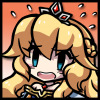
BWAAAAAAAAAAAH! I C-C-CAN'T TAKE THIS!

E-easy, milady! You swore before we began that you would not cry!

I, too, owe very, very much to all of you, so... I am very sad.

Where there is a beginning, so too shall there be an end... It is an inevitability.

Still, one might argue that as long as there are still decks to play with and opponents to challenge... Cipher may be played for eternity. So think not on this as the end, for this is but a milestone of life.

Sniff... So this isn't farewell?

Not in the least! All of our players can still continue to get together to play Cipher. So as sad as you might be now to see the game end, the feeling won't last! And I, for one, would like to close out our final day with a smile.

To that end, I propose that we all share some parting words. You first, Emma!

Alrighty! Well, I've been here since the beginning, but... Back then, I was an absolute noob, wasn't I? I didn't have the faintest idea what a "Tea See Gee" even was!

But then I learned so much from Shade, and I presented news, participated in Tryout and Gathering events, and watched Live Broadcasts - and all of that gave me the chance to grow so much.

And then as the days went by, we got to meet Yuzu and Randal, Alice and Valjean, and Niamh and Poe, and we all always had a riot of a time playing Cipher together... It's all been like something out of a dream!
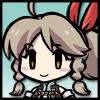
Lastly, I just want to say thank you...

To all of you who've been reading our column to date, thank you tho thuch!

Ha! Is that a slip of the tongue I hear?

Why, I do believe it was... And of all the words to flub, at that.

H-heh heh heh! I guess I am still just a kid after all... But mark my words, I'll be working even harder to become a mature, full-fledged knight! Okay, let's try this again... Thank you all!

Well, I'm next! I was primarily tasked with hosting this column and presenting news.

But the work introduced me to more and more friends, and to a constant stream of announcements that were news to me myself... To lose it is like I've also lost my reason to exist, but at least I am left with fond memories of it all.

My desire to convey the appeal of Cipher to others hasn't wavered in the slightest, but... this is the last time it will ever happen here. Alas. Still, I will always be rooting for all of you, even if we don't see each other.

There will always be a bond between us - always. Remember that whenever you play Cipher and see our cards. On this, you have my word! This has been Shade, shepherd of wayward lambs, saying farewell!

Alright, then. You're next, Yuzu!

...
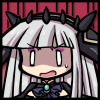
Huh? Yuzu! What's gotten into you? Would you just get out here?

Er, forgive me. When everybody's gaze turned upon me, I could not help but immediately seek shelter...
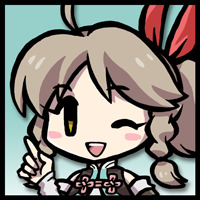
Oh, yeah. You never did like public speaking, did you, Yuzu?

Of course! We had a devil of a time convincing you to come out at all for your very first column.

E-enough! That was many years ago: a d-d-difficulty that I have long since moved past!

Hrr-hrr-hrr... heh-HEM! L-l-let us, er, begin anew.

I am Yuzu. My contribution to this column was to introduce cards that afforded new styles of play... only to let a haze of utter passion promptly consume me and hence spend my every waking hour crafting decks from them and trialling them in matches.

You always were one to cry, "I must test these cards at once!" and throw yourself into obsessive research.

As such, I have acquired an eye for strategy, forged in the fires of Cipher, to incorporate into my prior mastery of the martial arts - and with that, at long last, I have come to an understanding of the very heart of warcraft.

Further, as a consequence I may declare with confidence that, should I ever find my brother, I shall be able to hold my head high for all that I have grown in his absence. For that, you have my most heartfelt gratitude. So end my parting words!

Thank you, Yuzu. Right, it's your turn, Randal!

Huh? Oh, right then!

I've got a motto: always take your games deathly serious, and always make your own fun on the job… And, well, this has been my chance to prove those words true.

I mean yeah, I'm a wanderer at heart; I might've stuck around a bit too long... but that's just because this was all a hell of a lot of fun.

Oh, I agree... It was a HELL of a lot of fun!

GAH! It's... It's you!

Well, well. We have a stranger among us!

Pah! "Stranger," indeed. This hair, this face, this ribbon... None of this ring a bell?

Eh? Do you... do you mean Randal?

Indeed! I am...

...His son, no? It is nice to meet you!

OI!

What are you on about?! I AM Randal, just from the past - younger than the one you know!

It's happening again! The exact same argument!

This really must be the end, if HE'S here...

This is how you treat me? I have to hear that the last column is happening at the eleventh hour and make a mad dash to make it in time?! Bloody hell...
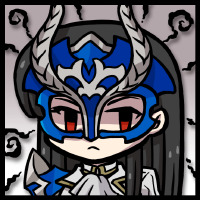
What is this? A being under the thrall of the Boundless Chaos? How intriguing. I must conduct a thorough examination at once...

H-hey! What are you doing, Niamh?! You look deathly serious... Oi, that's enough! Stay back! I... I've got a sword!

Well, er, I'm just about all out of time, but I just want to say it was a hoot being on the Frontier. Hope I see you all again someday. Adios!

He vanished?! Still more intriguing...

Sigh... What a pain in the arse, if I do say so myself. Although... I must admit, we do agree on one thing: I'd also be glad to see you all again.

This might be one farewell, but here's hoping we cross paths once more! And if we do, hey, why not play a match with this old fart? And that's all she wrote from ol' Randal!

Thank you. Next, let's hear from Alice and Valjean!
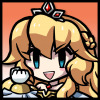
Heh heh! At last! Shall we, Val?

Yes, milady.

The two of us made our debut circa Series 10, and ever since that day, the Frontier never failed to be a most thrilling time. Would you agree, Val?

Yes, milady.

My objective in making this journey was simple: to experience much in my travels, such that I might someday return home and become a great ruler indeed. But instead, I first became a most superior, most brilliant Cipher player! Utterly invincible! Favored by fortune! And whatnot. Didn't I, Val?

Yes, milady.

I remember... that every time a Cipher release day came, I would be up all night from their eve, crafting decks and playing matches with the others. Oh, it was such fun! Wasn't it, Val?

...Yes, mi... mi... milady! Sniff...

V-Val?! What is the matter with you?

I am most moved. That my most capricious liegelady could at last find in Cipher such an engaging hobby, such good company, and such a source of training - and that she could grow so greatly as a woman.

Val...

We have been truly blessed to have had all of this: all of you, who welcomed us so warmly into the Frontier fold, and all of the Cipher players out in the world. I wish to offer you my gratitude for everything.

To be honest... I have something to say on that matter myself. Thank you, truly, for everything. I will never, ever, ever, EVER forget even a single day that we spent here together!

Nor shall I!

...Having said that, milady, I fear that you are still yet unready for the throne! From today onward, we must redouble your original leadership training efforts! I fully intend to prepare for you an intensive study regimen.

I-I-I beg your pardon?! You will not speak to me so! If I see even a single incorrect mark, you would do well to prepare yourself, for I will work you to the very bone for the rest of your days!

By all means, do it. But be prepared, for I have a lifetime's worth of admonishments at the ready.

Heh... Best of luck to the two of you!

Your turn, Niamh!

I was present from the 37th column onward... To be precise, it was in the "Love and Bonds Special Talk CD" audio drama that came as a set with an artbook, sold at Comiket 93.

My inquiry and research into the miscellaneous phenomena of this world, and the Boundless Chaos in particular, shall continue, but...

...

Well?! Don't tell me that's all you have to say!

...No. To me, my inquiry into Cipher represented the introducton of a new, major challenge into my life. Cipher decks... Gameplay... Which solution is correct, and which is optimal... As yet, I still have found no answers. As such, it is vital that going forward, I collaborate with a broad sample of Cipher players and find an answer...

So what you're saying is, you enjoyed playing Cipher with everyone, and you're gonna keep playing forever!

That, er... Ahem! That's pretty much it.

Cryptic remarks if I ever heard them, but certainly Niamh-ish.

Right, let's keep this going with Poe!
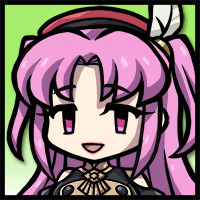
Only a year and a half has passed since I was welcomed to this column, and sadly, in the end our association has been brief. But I was able to have a very fulfilling time with you.

Attending that Winter Comiket thing with all of you, playing the "Recite and Play: Heroes Iroha" card game being sold there... They were very happy days.

And in all of that, I have always been monitoring Niamh...

...

Hee hee... You have been a good girl here, have you not? I do nothing to good girls.

If one of you becomes wicked, at that time I shall... Heh... Heh heh heh heh heh...

So, I pray that we never have an unpleasant reunion, and end my speech. Thank you. This has been Poe!

Heh... Let's keep that warning in mind.

...With that, have all of us spoken?

Tsk tsk... We aren't actually finished just yet! Since this is our last column, allow me to call upon a special guest!

...A guest? Wait, you don't mean...

Ta-daaaaa! Here he is!

Hello, everyone! I am Kawade, the producer of Fire Emblem Cipher.

K-K-KawadeP!

My, what a surprise!

The publication of the final Frontier coincides with, at last, the end-of-March termination of event support for Cipher. So I thought I would share a message for all of our readers and Cipher players.

If you count from when Cipher was first announced, roughly six years have passed. That's a long time, yet it's just flown by... These have been very busy years, but also wonderful ones, absolutely full of memories and events.

In that time we've constantly taken on new challenges - not just the production of Cipher itself, but Twitter content, live broadcasts, and staging events all around Japan.

And through all of that, we've had the chance to meet so many fans of Fire Emblem and Cipher... That was not only the most fun part of all, but a part that made us happy.
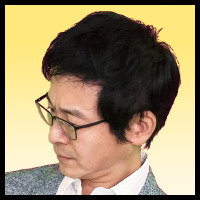
Although, we were unfortunately unable to hold any of our planned events for our final year, and for that I am truly sorry to all of you.

Still, we staff stuck with it to the very end, and as a result were able to complete Cipher as a fantastic game that can be played for years and years to come. For that, we are proud of ourselves.

It was thanks to all of you, who kept on supporting us, that we could continue our work to this standard all the way to the final series. I am overcome with gratitude to you all!

Production might have come to an end, but Fire Emblem Cipher will never die! It would make me happy if, every now and then, you might bring your cards out and play with them. Thank you all, truly, for everything!

And that concludes KawadeP's remarks!

Whew!

That, I believe, is everything that we wished to share.

Aye, I've got nothing to add.

So I suppose this is it: the end of the Cipher Frontier's long run.

Er... Shade? Can I say one last thing?

Hm? What is it, Emma?

Thank you for taking the lead in hosting this last one... And thank you so much for all the things you've taught me!

(Emma...)

H-hey! That's enough of that! You're about to make me cry, and that wouldn't be ending this day with a smile, would it?

Heh. I guess not!

So hey, let's give them one last, enthusiastic That Thing before Shade bursts into tears!

Very well, then. That Thing it is! This has been The Cipher Frontier!

With Emma...

Shade...

Yuzu...

Randal...

Alice...

Val...

Niamh...

...and Poe.

Now, then...

Let's do it, everyone!
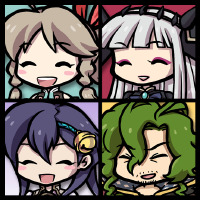
One...
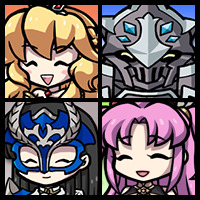
Two...

CIPHER!!!!!!!!
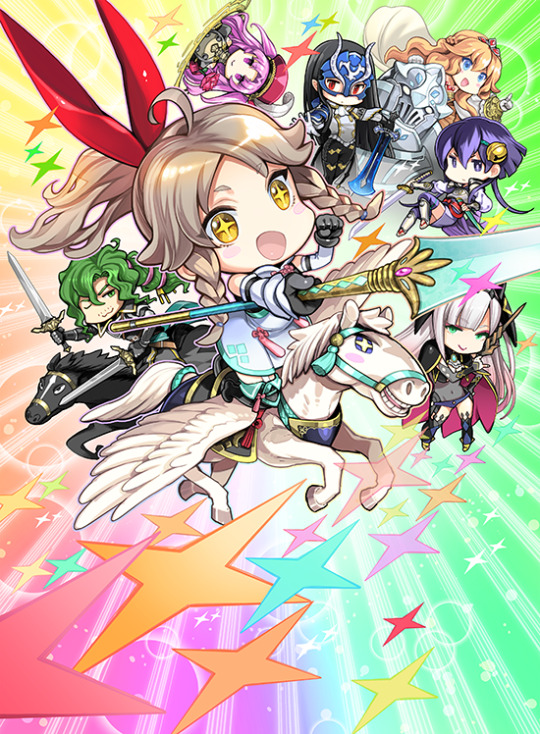
THANK YOU FOR EVERYTHING, EVERYBODY!!!!!!!!
...
...
...
...
FIRE EMBLEM CIPHER The Cipher Frontier! With Emma, Shade, Yuzu, Randal, Alice, Val, Niamh & Poe

Emma Emma continues to train in order to become a full-fledged pegasus knight. Her tireless Cipher training also continues, but she has yet to show much improvement at the game.

Shade Veteran mage that she is, Shade continues to teach the next generation. Many seeking to become almighty Cipher players have come to her, only to struggle bitterly under her tutelage - yet at the same time, to Emma and the others, she remains a nurturing guiding hand.

Yuzu Yuzu embarked on a journey of martial training, all the while following whispers of her brother's whereabouts... although evidently, she does return from her travels from time to time, bearing souvenirs, to partake in Cipher matches with all of her friends.

Randal Randal made a truly once-in-a-lifetime wager, only to go into hiding thereafter. Some rumors attest that he won, and that with that windfall he secured for himself a carefree life of quiet leisure in some southern land - others, that he met with a catastrophic loss, and was hence forced into labor in someplace.

Alice Alice's travels continue, as she seeks all the experience that she needs to become a true leader. Although at first she struggled, she grew to thoroughly enjoy it, and so she will persist in her journey without ever taking a break to return home... Or so she tells herself, at least.

Valjean Valjean continues to travel all across the land with his liegelady. Witnessing Alice grow ever stronger and wiser by the day, he cannot help but feel conflicting feelings of joy and loneliness beneath the privacy of his helm.

Niamh Even as she continues in her pursuit of wisdom, Niamh silently carries out research into Cipher. Her seminal monograph, "A Compendium of Cipher Decks," is over 100 volumes in length, and by all accounts is still in print to this day.

Poe Poe vanished in her hunt for evil, and her whereabouts remain unknown. However, according to the afterword of "A Compendium of Cipher Decks," she and Niamh have since fought to the death on many an occasion.
The End...???
24 notes
·
View notes
Text
mercantilism and the humane state
All I remember about mercantilism from my world history classes in middle and high school are “and then they started trading a lot”. Azar Gat says in War in Human Civilization that it was a lot more important than that – mercantilism was when an entirely new build (in the game sense) of nations arose, forcing less competitive nations using the old build to switch over to the new build, with the concomitant social changes.
Although pre-industrial European economy remained predominantly agrarian, mastery over markets of a global scale and a growing manufacturing sector, which prospered by virtue of that mastery, became a very significant source of wealth, of a more liquid sort than previously known. ... The states that won out in the contest for domination over global trade secured the resources that made them strong in the European power struggle. ...
Whereas earlier in history power brought wealth, while wealth translated into power more equivocally, wealth and power were becoming increasingly interchangeable. No longer was there such a thing as a poor strong power. Consequently, to survive, power had to serve the interests of the producing and trading economy, and the more it did so the more power was generated. Any shackles put on social wealth creation by the state’s political and military elite only undermined the power of that elite in competition with other states. For the first time in history parasitic warrior states and warrior elites were falling behind economically productive states and elites in terms of power.
As I understand it, the old build (used by the most powerful states pre-mercantilism) works something like this. You’re a state, probably ruling over disparate populations who don’t see themselves as one people, and your purpose is to maintain your borders, tax the agrarian peasants within those territories, give them enough social goods so they won’t rebel, maintain enough of an (expensive!) horse warrior elite that can keep peace within the realm and quickly move around the border to repel invasions. The more cooperative geography is (as in China, but not in Western Europe) the larger and more successful a state you can build.
Or the other winning build: you’re the horse warrior nomads who are responsible for a lot of the border incursions. You have a pretty good life because you move around a lot and can hit a variety of locations on the border of the local wealthy state (and they can’t strike back at you because you don’t have a fixed location where you keep your stuff) and extort them for tribute.
In neither of these builds is trade important for staying in power. Despots ruling over centralized empires, in times of need, tended to loot temples or merchants or – if you could get away with it – aristocracy fallen out of favor. Merchants were never the source of wealth anyway, not while trade was of a pre-global scale – the agrarian populace was. You could impose heavy taxes on them or loot them outright and it was approximately fine. Your state build didn’t depend on them. It is the sixteenth century, and things seem like they’re going well, same as they have in the last two thousand years.
Meanwhile, the Western European nations that won at the naval exploration & global trade thing are getting fantabulously wealthy, and using that wealth to build their armies and invest in advanced tech like guns (which amplify the power of navies). Other states like China could have gotten there first (and it’s not really clear to me why they didn’t):
After Cheng Huo returned from east Africa in 1433, the Ming decided to dismantle their advanced fleet of ocean-going junks and banned further long-range voyages. State funded, these voyages had been costly and their rewards dubious. A renewed nomadic threat from the north directed the imperial government’s attention and resources elsewhere. Nor was long-range naval activity allowed to proceed in private hands and along more commercial lines, because the despotic Chinese state with its Confucian mandarin bureaucracy disliked and suspected trade, traders, and independent capital.
(I recall from James C Scott’s Against the Grain that one reason old agrarian states hated merchants is that they, unlike farmers whose primary assets ripen at predictable times of the year for tax collectors to descend upon, can move around and hide their wealth.)
Using their newfound wealth and productivity, the Western European states waged wars on each other. States that hadn't hooked themselves into the wealth-power feedback loop lost out. Gat emphasizes how important military struggles were to propagating the new system – reforms to make a country more trade-ready were forced on nations because they could not otherwise keep up. Suddenly you had to be nice to your merchants. No looting them whenever you’re short on money! – they’ll flee your country and take important capital. Prussia and Russia – autocratic centralized states without much of an aristocracy-poised-to-become-merchants class like England – had to force a merchant class into being, alongside a state bureaucracy for industry to hang on.
(Much less confident about the following parts because the parts I’m summarizing took place in a boring stretch I hated reading. If I force myself to reread it I’ll clarify my understanding in a reblog of this post.)
The way Azar Gat tells it, the transformation of a state from mostly an entity that exists to extract surplus from the population (he memorably called Assyria “a highly developed looting and extortion machine”) to an entity that exists to takes care of its citizens happened after the new, trade-oriented state build took over.
Indeed, growing modernization necessarily drove [Russia and Prussia] into intractable domestic tensions and contradictions, conflicting with and undermining the authority of the autocratic regime and traditional agrarian elite that ruled these societies. Modernization increasingly forced them to incorporate wider segments of society into the state in order to remain competitive in the economic cum military race.
(And he thinks the Western European states won the ‘discover the new market-based build’ round because the “wider segments of society were incorporated into the state” process had already happened there more than in centralized imperial states like China – for historic reasons I don’t understand well, Europe had much relatively decentralized states with a strong aristocracy that the monarchs had to compromise with more often to get things done.)
Switching over to a market-based build made it sometimes, somewhat, advantageous to give more citizens more rights. They’re more economically productive. It turns out they make better soldiers when they buy into the project of having a state. There’s a bit about how, around and after the French Revolution – when the “everyone should have rights” thing has really sunk in – the French army is more effective than you’d expect given its size, because they have much better morale and less desertion.
I don’t know how correct this story is! I’m sure even very well read people argue a lot about it. But the Big Idea here is fascinating:
States, everywhere, for most of history, were big extraction machines from the citizenry for the benefit of the rulers. The more the geography aided this extraction, as in China, the stronger the apparatus that moved resources up the chain. The exceptions came in states where that apparatus was weak, which were more prepared to move away from the local optimum when a new opportunity came by. Somehow there was some technological/material change that triggered the spread of a new system of ruling, in which where optimizing straightforwardly for extraction happened to trade off against acquiring wealth and power. And only then did states sometimes become an entity whose purpose was to provide for its people rather than funnel resources up to the ruling class.
We have something good – the idea and reality of states that exist largely to provide for its people – and it came so... so accidentally, as the consequence of a little avalanche that carelessly reorganized some feature of material reality.
38 notes
·
View notes
Text
Mirror & Misdirection - The Distortions of the Mirror Scene

How excessive, myopic emphasis on the Mirror Scene distorted both the fandoms and Brykes’ understanding of Azula, and what the Finale actually says about Avatar’s most controversial villain.
Executive Summary
To understand any fictional character, you have to understand their Goals, Motivations and Conflicts. This applies to Princess Azula from Avatar: The Last Airbender.
Ever since Azula was humanized in the Finale, arguments have raged over whether or not she has the capacity for meaningful growth and change like any other character, or any other human being.
At the core of these arguments has been the infamous Mirror Scene where, while talking to an hallucination of her mother, Azula expresses doubt, regret and tear-stricken grief. As a thoroughly established villain who had never before shown such feelings, this scene was taken as character-defining.
However, the Mirror Scene alone does not reveal all of Azula’s Goals, Motivations, and Conflicts. Instead, the Mirror Scene, when taken by itself, is only a Conflict. As a result, the Mirror Scene has distorted both the fandoms and Brykes’ perception of Azula by assuming she is entirely the work of complex, vague and puzzling psychological phenomena surrounding her mother, versus a variety of well-defined Goals and Motivations.
In actuality, the Finale gives us two other scenes that, combined with the Mirror Scene, give us everything we need to understand Azula’s Goals, Motivations and Conflicts.
In this article, I will provide an alternative explanation of Azula’s character that relates directly to the source material and which does not rely on psychological theory.
First, I will summarize the “Azula Debate” to provide proper context for this subject.
Next, I will explain the character-building concepts of Goal, Motivation and Conflict and why they are especially critical to devising a workable understanding of Azula.
After that, I will explain how the Finale yields Azula’s Goals, Motivations, and Conflicts, and I will provide an alternative explanation of the Mirror Scene as it relates to them.
I will then explain why the fandom incorrectly fixated on the Mirror Scene and how this distorted both the fandoms and Brykes’ understanding of their most controversial villain.
And finally, using these Finale-revealed Goals, Motivations and Conflicts, I will suggest a “path forward” for Azula’s further involvement in the Franchise.
The “Azula Debate”
When the Finale aired in 2008, one of the most striking and controversial developments was the rapid humanization of Azula. For the first time, we saw the fearsome and always-winning Princess scared, paranoid, emotionally fragile and crying. It was a radical shift from our previous image of Avatar’s most hated villain. Nothing like it had yet happened in the Franchise.
The topic of Azula’s newly-revealed humanity was so compelling that even Mike and Bryan were asked about it in the Sozin’s Comet novelization. While their answers were vague and disjointed, the fact they had an affirmative answer shows that Azula’s humanity wasn’t an accident; it was intended.

And the fans saw this: they saw an Azula that was more complex than what they had been previously shown, or lead to believe existed.
While Azula’s breakdown in the finale was well-animated, scored and voice acted, and the show wrapped up nicely overall, the Finale created more questions than answers for the Fire Princess, most of which still have not been answered to this day.
What is Ursa and Azula’s relationship? What is Azula’s moral compass? What does she value? What is the extent of her empathy? What lines will she not cross? Why does she use fear to control people? Does she enjoy hurting people? Can she feel love? What does she want in life? Why did she throw bread at turtle ducks? Is she a sociopath? Will she reconcile with Ursa? Is she mentally ill? Will she ever rise from the ashes of her shame and humiliation? What happens to her next?
These were the sorts of questions fans were asking in the aftermath of the Finale, and which fans are still asking.
Unfortunately, the fandom did not approach this topic with unity.
What began after the Finale was an endless back and forth about morality and affective empathy; psychology and personality disorders; juvenile delinquency and abuse dynamics; Dracos in Leather Pants and Freudian Excuses, with one side arguing that there wasn’t anything inside Azula worth exploring, while the other side desperately clung to the hope that there was potential for compelling growth in Azula. You could term the “anti” side the “Azula Haters” and the “pro” side the “Azula Fans”.
The “Azula Fans” are a diverse group that cannot be generalized. In summary, they found Azula compelling for a variety of reasons, they had questions they wanted answered and they desired to see Azula fleshed out fully.
The “Azula Haters” are equally a diverse group and so cannot be generalized. Overall, their motivations are primarily to relate Azula to real-world bullies and abusers, thereby preserving her as a platform to talk about escaping domestic abuse situations and how to give up on toxic family members. Relating Azula to the real-world in this way is not to develop the world of Avatar and its characters, but to express their own anger, cynicism and heartache over what’s occurred in their own and other’s lives, and teach lessons about it.
The key point is this: the purpose of the Azula Debate was not to discover the truth about Azula and determine how to tell a story about her. It was to either admonish “Azula Fans” for being misguided and ignorant in their understanding of Azula, or to prevent the “Haters” from discouraging their last, major interest in Avatar.
In the twelve years that have followed since the Finale, neither side has “prevailed”.
Aaron Ehasz has spoken about the potential for a Post-Finale Azula arc whereas Mike and Bryan have said little, or nothing. Wheras the fandom can all agree about their love for the heroes, Azula is like talking politics at a family gathering; it will not be pretty and passions will be inflamed.
While Azula was brought back in The Search and Smoke and Shadow comics, these works yielded few, if any, answers to her developments in the Finale, and she remains a divisive character. In fact, much of her complexities established in the Finale were ignored in The Search and erased entirely in Smoke and Shadow.
It can be argued that the Azula from the show did not actually make it into the comics and still remains “in an asylum off the coast”, waiting to be further developed. As a result, both Azula Fans and Haters argue to this day with no end in sight.
Driving these debates is the fact that nobody, not even the Creators, have provided a comprehensive, question-answering, Franchise-consistent explanation for Azula that combines her wickedness with her humanity.
To Haters, Azula is the embodiment of all things awful and terrifying that must be removed from society. To Fans, she is the potential for another compelling character-driven story utilizing the original cast.
A word frequently used to describe these “compelling” additional stories about Azula is “redemption”. This is a vague word with multiple meanings. Typically, both Avatar fans and the Creators interpret this as a character who is morally good on the inside realizing their mistakes and atoning for them; these characters are not truly bad people; as long as we don’t think they have crossed any moral “lines in the sand”, they can be accepted into the circle of “good people”.
This is what has caused debates surrounding Azula to be focused on questions of morality, affective empathy and psychological disorders instead of her Goals, Motivations and Conflicts; if “Haters” can prove that Azula is genetically bad, then there is no potential for a story about her because it is impossible for her to change and grow, and stories require their characters to change and grow. On the other hand, if “Fans” can prove she is “human”, then she does have the capacity to change and grow, and the themes of the Franchise can be applied to her.
Unfortunately for Azula Fans, there are two seasons of wickedness, smirking and bedeviling Zuko to back up the Haters’ position.
But Azula Haters also have to contend with the Finale. It demonstrated the existence of Azula’s humanity and was an intentional decision by the Creators; Fans are not “reading into” it. Even Katara felt Azula’s humanity.

So who is correct?
Well, the Haters are, for the most part.
The show spent a lot of time portraying Azula as unnecessarily cruel without a shred of self-doubt, suggesting her villainy is not just a matter of her upbringing and choices, but intractable psychological defects. Even the Creators wanted Azula to reflect a “deeply rooted malevolence.” To counter this, Azula Fans point to the Finale, and more specifically, to the infamous Mirror Scene.

The Mirror Scene shows Azula expressing doubt, remorse, hurt and even tear-stricken grief. The Mirror Scene has been used by Azula Fans to explain all of Azula’s humanity, sort of as a Rosetta Stone of her innerworkings. Even the Creators seem to think this way, as shown by their answers to the Sozin’s Comet interview, and their choice to make Azula’s relationship with her mother in The Search take center stage, and drastically so.

THIS. IS ALL. WRONG.
In order to understand a character, you have to understand their Goals, Motivations, and Conflicts. Any character, especially Azula.
The Mirror Scene and her relationship with her mother are not what’s vital to understanding who Azula is, what she wants and how she fits into the Avatar world. This is not an attempt to be “edgy” or “different” or “contrarian”. You will never, ever find your answers in The Beach or in the Mirror Scene alone, no matter how hard you try. This is because the Mirror Scene is only one of three scenes from the Finale that must be taken together to understand Azula on a fundamental level.
The Mirror Scene is not enough. It has not answered the fandom’s questions about Azula’s Goals, Motivations and Conflicts. It has not provided a compelling argument against the evidence that she is a monster whose villainy was only limited by the censors and, most importantly, the Mirror Scene is not Azula’s most defining moment.
These three, together, are:

And I will explain why.
Understanding Characters: Goals, Motivations, & Conflicts
This section gets into some of the “nuts and bolts” of storytelling, but it is necessary for understanding Azula; she is too complicated and the source material too thin on her. Stick with this and you should learn something.
In order to understand a character, you have to have a clear understanding of their Goals, Motivations, and Conflicts. Other writers have different terms for these concepts (Need, Want, Desire, Obstacle, etc.), but they are universal to storytelling.
Stories are not meant to be exact replicas of real life. Yes, they can say something about life, but ultimately, stories are about characters having problems to solve and their journeys to solve them. It is not enough for a character to just “feel”. They have to want things, need things, do things, and something has to prevent them from getting what they want and need.
Conflicts are what prevent characters from achieving their goals (their wants and needs). Motivations are what drive characters to pursue their Goals, and Goals are what characters strive to physically achieve.
Goals are physical; they can be touched, held, acquired. They can be a person, a place, or a thing. They are not emotional or psychological. “Love” is not a Goal. Being in the arms of someone or waking up in bed next to them, however, is a goal. Goals are what enable characters to be active in the story, to move through the world, exert force on their surroundings. Sitting on the sofa, or ruminating in a prison cell are not Goals; getting up to join the protest or hatching an escape plan are. At the same time, “wanting power” is not a goal, but “becoming president” is.
For some Avatar examples, “Capture the Avatar” is a Goal. “Master all four elements” is a Goal. “Liberate Ba Sing Se” is a Goal, but “My mother thought I was a monster” is not.
Goals, however, do not exist by themselves. They are the result of Motivations.
Motivations are internal. They are abstract. They cannot be touched or acquired. They derive from the thoughts, feelings, philosophies and psychologies of the characters. Some motivations can be caused by external forces, such as fear of breaking the law, a military commander giving an order to a soldier, or the threat of dying from starvation, but those external forces are not Motivations: fear of imprisonment, commitment to one’s leaders, and the will to survive are because they are emotional, philosophical, psychological.
Motivations are where characters encounter those moral “lines they won’t cross”. It’s where they doubt themselves and wonder if they are willing to go “all the way” to stop the villain. Motivations are what drive a character to question if they should kill the man who murdered their mother, if they should kill the Fire Lord and ignore their culture, or betray their uncle to return home. Without Motivations, characters are robots. With Motivations, characters become people.
But a story where characters face no opposition is not a story. This is were Conflicts arrive.
Conflicts prevent characters from achieving their Goals. They can come from a variety of sources: internal or external; emotional or religious; psychological or philosophical, or combinations thereof. Conflicts can stem from Motivations (for example, somebody violating their moral code), but they are not themselves Motivations. For example, if a character is motivated to carry on the cultural values of their lost people, but their duty requires them to violate that culture, their struggle to reconcile the two is a Conflict. Or, if a character is motivated to be the image of the son his father wants, but finds out that image is completely against everything he stands for, his struggle to remain at his father’s side or leave is a Conflict.
The type of Conflicts that “build character” are the ones that result from Motivations, not merely external forces. A character simply climbing over a fallen tree is not as compelling as a character who must decide if they should cut down the tree when there’s a nest of endangered owls living in it. Characters must decide for themselves. They must struggle with their feelings and values.
However, Goals, Motivations and Conflicts are not the end-all-be-all of character. Characters can have secondary goals and motivations. They can have quirks, flaws and personality traits that give them depth and round them out, but their Goals, Motivations and Conflicts are what creates a story about them. They’re why Zuko being willing to burn down Kyoshi Island does not tell us the full story of Zuko, but it tells us something about him. They’re why Azula hanging Ty Lee over a burning net does not tell us the full story of Azula, but it tells us something about her. And they’re why Aang killing a buzzard wasp in cold-blood does not tell us the story of Aang, but tells us something about what he’s going through and what will make him ignore his values.
In short, we have to know a character’s Goals, Motivations, & Conflicts in order understand them, only then can a character be fully fleshed out in a story that makes them overcome diversity, change and grow.
The Goals, Motivations & Conflicts of Princess Azula
In order to answer the lingering questions about Azula, including how to tell a story about her in the Post-Finale world, you have to understand what she wants, why she wants it and why she is unable to have it. In other words, you have to understand her Goals, Motivations & Conflicts.
As it turns out, the Finale gave us all of this. Now, keep in mind, the Finale doesn’t tell us everything about the Fire Princess, just like how the show doesn’t tell us everything about General Iroh prior to Lu Ten’s death, but the Finale tells us enough in order to develop a workable explanation of her character. This explanation of her character was revealed in three scenes, starting with the one in The Phoenix King where she is speaking to her father on the platform, followed by the scene in Into the Inferno when she is talking to Lo and Li in the throne room, and, finally, the Mirror Scene.
Not everything is explicitly stated and neither does it explain her bullying, teasing, smirking and smugness, but it doesn’t have to. Those are flaws, quirks and other personality traits. These three scenes in the Finale give us the big stuff; the information that’s needed to tie her into the franchise at large and make her a product of the Avatar world versus a mere set of villainous qualities.
And it begins with The Phoenix King.
Pivotal Azula Scene #1: The Phoenix King

I’m sure you can picture it: Azula racing to join her father on the platform, getting told she’s being left behind, frightened because she thought they were going to burn the Earth Kingdom together, snapping at her father for treating her like Zuko, desperately insisting she deserves to be by his side, and, finally, flinching as she gets yelled at.
That’s some big, heavy stuff, huh? She’s been afraid of being treated like Zuko all this time? Burning down the Earth Kingdom is some child-like, emotionally needy ploy to be with her father?? She feels she deserves to be by his side?!? Azula has problems?!?!?
This scene reveals a portion of Azula’s Goals, Motivations and Conflicts.
Before I begin, I must warn you: I’m not going to spend a lot of time using clever words and metaphors to convince you. If you ever have the urge to shout “But wait! I disagree with that and here’s all the reasons why!!” I encourage you to slow down, approach this with an open mind and try to ignore your existing ideas about Azula. Forget about her smirking and smugness, her throwing bread at turtle ducks, her tormenting of Zuko and especially the psychological disorders that people have tried to tie her to. We are focusing on her Goals, Motivations & Conflicts as revealed by the Finale, not essays and fan interpretations. We are applying time-honored storytelling principles to Azula as if we were trying to tell a professional story about her.
Azula’s Goal #1: Be With Her Father
In the Phoenix King scene, Azula said she wanted to “do this together.” She said she deserves to “be by his side.” She doesn’t want to stay behind. These are physical, tangible things. They comprise a Goal.
Why does she have this Goal? Don’t worry about that right now; we’ll get to that later, but right now, the Phoenix King shows and tells that Azula wants to be in the presence of her father. She wants to stand next to him. She wants to do things with him, and she is willing to snap at him over it. This scene also reveals her Motivations.
Hold on. Wait. Stop. I know you’re doing it; you’re thinking, “”But they’re both predators feeding off each other! ‘Be with her father’ must actually mean something sinister and her real goal is to extract power and influence off of him!”
Stop.
Relax.
Forget all of that. We are exploring what the Finale shows and tells us. Ignore fan theories. We are in unexplored territory right now.
Azula’s Motivation #1: Not Be Treated Like Zuko
Not being “treated like Zuko” is abstract. Being “treated like Zuko” means being openly disrespected, thought of as irrelevant, viewed as a disappointment, not being wanted, sent on fool’s errands, belittled and cast aside.
Being challenged to an Agni Kai isn’t being treated like Zuko as the Agni Kai is a standard Fire Nation practice; child Zuko was perfectly willing to fight the general over his mere “disrespect”. If the General had burned him, would the General have been treating Zuko “like Zuko”? Neither is the act of being physically punished being “treated like Zuko”; lots of kids in the Avatar world probably get physically hurt by their parents. Terrible, but not unique.
It’s not the physical abuse that makes someone be “treated like Zuko”, but the emotional. In a society where Agni Kais are commonplace and soldiers are expected to be tough and aggressive, being “treated like Zuko” is a state of mind; it is emotional, philosophical, psychological. Think of it this way: if Azula had been challenged to an Agni Kai, fought with aggression, and Ozai “merely” burned is favorite on the arm somewhere to end the fight because it had served its purpose, and later expressed pride to her because of her aggression, would that physical harm be treating her “like Zuko”? The Fire Nation’s leadership is supposed to have a warrior culture.
In the Phoenix King scene, the Motivation behind Azula’s Goal of “being with her father” is not merely to avoid the physical harm of an Agni Kai, but her fear of being “treated like Zuko” and everything that means. This isn’t the entire message of the Finale, but it’s what this particular scene is saying, and Ozai’s response to Azula’s fear reveals one of Azula’s Conflicts.
Azula’s Conflict #1: Her Father Doesn’t Want Her
Imagine if Ozai had taken Azula with him and they drank tea, played Pai Sho while and, together, lost to the Avatar. She’d probably be far less distraught than she was at the end of her Agni Kai with Zuko. Certainly her hair wouldn’t have been disheveled and she wouldn’t have been screaming and crying.
What prevents Azula from achieving her Goal of “being with her father” is that her father doesn’t want to be with her.

Look at that sequence closely, in particular the change in Ozai’s expression after Azula arrives. Is that the face of a man who wants his supposed favorite around?
Wait. Stop. I know you’re doing it again: you’re thinking about Ozai’s capacity or lack thereof for love, why Azula feels this way or what her ulterior motive is or what psychological disorder is driving her to cling to him like a parasite.
Once again… Relax. We’ll get to that. Just focus on what the Finale is telling us here: Azula wants to be with her father (a Goal), she is scared of being treated like Zuko (a Motivation), and her father is not giving her what she wants (a Conflict).
Does Ozai assure her that he isn’t treating her like Zuko? Does he put his hands on Azula’s shoulders and tell her that that isn’t what’s happening?
No!
He buys her an expensive car to get her to shut up. Azula hasn’t been given what she wants in this scene. “Fire Lord Azula” is not being at her father’s side. Being coronated is not “doing this together”, in fact, it’s leaving her alone. It can be argued that Ozai manipulated Azula in this scene by giving her something she wanted, so how was he able to manipulate her?
By understanding her Goals and Motivations, next of which are revealed in the Throne Room Scene.
Pivotal Azula Scene #2: The Throne Room

Ever hear the phrase “show don’t tell” in storytelling? Show the reader what the characters feel and what they want? Show what a character is willing to do to achieve their goals? Well, sometimes you do need to tell a reader what a character is thinking in order to make it starkly clear to them, and in the Throne Room scene, we get just that: a clear statement by Azula of what her Goal is, and it is a whopper.
In fact, this stated Goal by Azula is so monumental that it can be considered character-defining. It ties her royalty into her relationship with her father into her being a prodigy into her high standards (“almost isn’t good enough”), even into her struggles to be a “normal” teenager in The Beach. It makes the “Princess” in Princess Azula actually mean something. It makes “Princess of the Fire Nation” actually relate to the Fire Nation.
Azula’s second Goal, as stated explicitly in the Finale, is to be the greatest leader in Fire Nation history. Those are her exact words.
Be something; a physical condition. It requires her to take action, to be active, to accomplish things. It is a Goal.
Azula’s Goal #2: Be the Greatest Leader in Fire Nation History
In the Throne Room scene of the Finale, Azula says that she will be the greatest leader in Fire Nation history. She says it. This is not an interpretation or “reading into” things. The Finale has told the viewer what the Princess component of Princess Azula wants to be when she grows up: the greatest leader in Fire Nation history. This is a Goal; something that can be physically achieved. While it is true that what constitutes “greatest” can be subjective, certainly it involves a combination of reputation and physical accomplishments, especially given the goals of the Fire Nation at the time: conquering other nations and advancing the country’s wealth and power.
That this scene has flown under the radar for so long is mind-boggling. It is akin to asking a child what they want to be when they grow up, only this is a flame-throwing, feudal-era teenager who is being raised to command armies. Look at it this way:
“Little Jimmy, what do you want to be when you grow up?”
“An astronaut!”
“Little Susy, what do you want to be when you grow up?”
“A doctor!”
“Little Princess Azula, what do you want to be when you grow up?”
“The greatest leader in Fire Nation history!”
Azula told us what she wants to be when she grows: the greatest leader in her country’s history. That is a pretty lofty goal that has been tempered by age or experience, something a young person could easily think they could achieve, but then again, maybe it wasn’t so unreasonable for her: she captured Ba Sing Se, defended the Capital from invasion and can bend blue fire and lightning at a young age.
So, why would a princess strive to be the greatest leader of her country versus just lounging around all day? That is for her Motivation to explain.
Azula’s Motivation #2: Her Father’s Expectations + Pride & Belief in Her Royal Title
This Motivation is really multifaceted, but in order to simplify things, it is being tied to her royalty in order to emphasize its connection to the Throne Room scene.
If “being the greatest leader” is a Goal, then the reason why she wants to be the greatest leader is her Motivation.
This is where some speculation becomes necessary. Even though the Throne Room scene stated this Goal very clearly, it doesn’t say much about why she desires this. You have two ways you can approach this question. First, you can cynically assume that Azula is motivated by nothing honorable or relatable, therefore she is closer to a parasite feeding off of the Royal Family, or second, you can assume she is a product of the world she lives in and so is motivated by things that can tell us about the Royal Family, the Fire Nation, and life under her father. Because the former results in no room for growth and change, and is entirely based on psychological theory, this article will assume the latter.
Because there are no clear answers for why she has this Goal in the Finale, I am simply going to list a variety of potential Motivations. Most likely, the answer is a combination of these at the same time:
· Ambition to achieve (like a great athlete striving for excellence);
· Enjoys challenging herself;
· Desires to be someone (famous, notable);
· Internalizes her role as Princess and sees herself as nothing else;
· Enjoys fighting, firebending and military subjects;
· Enjoys politics, ruling and statecraft;
· Excels at her royal role, so enjoys being good at it;
· Believes in the purpose of the Imperial Government;
· Takes pride in Fire Nation history and wants to contribute to it;
· Enjoys having power over people;
· Seeks praise;
· It’s what her father expects of her;
· Believes her father is a great leader and so wants to be like him;
· It’s what’s expected of a Fire Nation Princess;
· Wants to maintain the legitimacy of her family and “prove her worth”;
· If there’s any sort of sexism in the Fire Nation, maybe she feels she needs to work “twice as hard to get half as far”;
· Following the sexism angle, maybe she wants to distance herself from any “limiting” feminine roles;
· And others.
In the Throne Room scene, we are given a hint as to what might be one of Azula’s motivations for wanting to be the greatest leader in Fire Nation history: not being treated like Zuko (i.e. living up to her father’s expectations).
Right before she gives the aforementioned line in the Throne Room scene, she says to Lo and Li that her father doesn’t think she “can handle the responsibility of being Fire Lord”. Perhaps one of the reasons for pushing herself toward ever greater achievements and abilities is to prove to her father that she truly does deserve to be “by his side” and not “treated like Zuko”.
But Azula is also a princess. That is extremely important.
Azula is a member of the Royal Family and is a military and authoritarian leader by default. The Throne Room scene is the chance to inject the Fire Nation into Azula’s character, not just emotional disfunction and psychological dependency. Remember what kind of country Azula lives in: it is full of walking flamethrowers who must be kept in line.
Remember all the warfare in ancient Japan? No? Then take a look at this article, The East Asian Origins of Fire Nation and Its Villains, for an idea as to why the Imperial Government exists and why the Royal Family is very concerned about being successful, and using force and intimidation to do so.
“I want to be the greatest leader in Fire Nation history” is the chance to use Azula to convey broader subjects about the Fire Nation’s politics, history, culture and how they effect someone who is either too young or unable to be what is expected of them: a feared military ruler in a militarized society at 14 years old.
Also note that her goal of being the “greatest leader” was stated after she learned she would be Fire Lord. This means the Goal was not accomplished; the Motivation didn’t go away. Being Fire Lord is not being a great leader; it is simply being Fire Lord. To her, wanting to be the “greatest leader” comes from a much deeper source and, in fact, could be argued as a character-defining Motivation. Along these lines, Azula is not merely Azula; she is Princess Azula at all times, everywhere. To her, there is no “Azula”, but only “Princess Azula”. Her title is her identity.

You might have to apply some artistic license here, but you can do so in a way that is both faithful to the source material and builds upon it. For example, while the show was active, there was a description of Azula from the viewpoint of the Fire Nation on Nickelodeon’s website. Note that it sounds very similar to what Zuko said about his sister in Siege of the North: Part 2. This heavily suggests that not only is Azula what her father wants, but also what the Fire Nation and Imperial Government want in a princess.


To summarize, Azula’s second Goal is to be the greatest leader in her country’s history and her Motivation for this Goal is a combination of wanting to meet the expectations of her father and flat-out believing and taking pride in her role as Princess. But what about her Conflicts as a result of this Goal? Well, as the Finale demonstrates, she isn’t the greatest leader yet. Once more, some reasonable speculation is required.
Azula’s Conflict #2: She Struggles to Be a Great Leader
Azula felt she had to compel the Captain into taking the ship through the tides right now in order to exert her dominance (this is explained in the Tale of Azula novel). She relies entirely on fear instead of using a combination of trust and fear, like someone who read Machiavelli but wasn’t old enough to actually understand what it was saying; she failed to understand Zuko’s motivations and so he turned against the family; she failed to understand that people are willing to sacrifice their lives for loved ones, or even make stupid mistakes, so she felt personally wounded by Mai; she didn’t know how to handle both Mai and Ty Lee’s betrayal and so lost all faith in her subject’s loyalty; and she banished all of her servants and guards instead of figuring out how to act differently.
If Azula’s father is her “measuring stick” for success, then being at his side and doing things with him is not only protection against “being treated like Zuko” but also a sign that she is doing everything right as a leader in training. Remember that her Goal of being the greatest leader didn’t go away when Ozai gave her the crown; the Goal is coming from someplace deeper.
But Azula begins to doubt herself in the Finale. She begins to feel paranoid and she doesn’t have the life experience and knowledge to tell her why Mai and Ty Lee betrayed her, how to adjust accordingly and what to do differently. She’s never failed before. She’s unsure of what the future will be and she doesn’t have her father to measure herself against. She is not yet a great leader.
She wants to be the greatest leader in Fire Nation history, but how will she become that if she keeps failing and her father left her behind? She wants to be by her father’s side, but how can she be if she’s back in the Fire Nation struggling to have the loyalty of her closest subjects (guards and servants)?
If Azula’s second Goal is to be the greatest leader in her country’s history and the Motivation behind it is a combination of her father’s expectations and pride and belief in her royal title, then her second Conflict is that she doesn’t know how to be a great leader or live up to her father’s standards. In the Finale, she is trying and failing and she doesn’t know what to do.
This leads to the third and final pivotal Azula scene: the famous Mirror Scene.
Pivotal Azula Scene #3: The Mirror Scene
If there were any key emotions during Azula’s breakdown, they were paranoia, fear, anxiety, grief, uncertainty and doubt.
It’s been established by the Phoenix King scene that she wants to be with her father to avoid being “treated like Zuko”. Knowing what happened to Zuko, that must create a hell of a ton of fear, anxiety, stress and doubt within her.
It has also been established that she wants to be the greatest leader in her country’s history. That must also create a ton of fear, anxiety, stress and doubt: will she be the greatest leader? Will she fail? Does she even have what it takes? What if she doesn’t? What if Zuko is better than her? What will her father think of her? What will her country think of her?
During the Finale, she is paranoid about the consequences of disobedient, vengeful subjects who might assassinate her.
She doesn’t know what to do or what the future holds.
She is doubting herself, she is afraid she might fail.
She feels grief, but about what exactly?
There is a pattern emerging from the Phoenix King and Throne Room scenes. You have a teenage girl (remember, that is what Azula is) who is anxious and panicky about being left behind and mistreated by her father; you have a young, military ruler-in-training who has very high standards for herself and is failing to live up to those standards; and you have a member of royalty who is alone, afraid and doesn’t know how to deal with failure or handle what she is feeling.
Remember what I said earlier about ignoring your existing conceptions and feelings about Azula? Well, you also have to ignore the 30-year old voice actress and general appearance of being older. You need to think about the franchise at large.
What were the ages of the main characters: 12? 14? 16? 17 at most? Kids and teenagers, essentially. That is a unique selling point of the franchise—young people going through adversity—and it makes it easier to feel sympathy for them, just as the youth of the characters in the Hunger Games made it more relatable to kids and teens, and allowed adults to feel sympathy as well (adults are the ones who take care of kids and teens).
In fact, the characters of Avatar being kids was an important part of the story: themes of family were critical to Katara, Sokka, Toph, Zuko, Mai, Ty Lee and even Azula (in the end). Therefore, you have to keep in mind the importance of youth to the main cast and franchise at large.
How old is Azula? 14-15?
Do you now see the pattern?
Who do kids and teenagers rely on when they are in trouble?
Who helps them understand their feelings?
Who is supposed to have all the answers?
Who tells them they’ll be okay, they’ll figure it out, they’re not alone?
Parents.
What is Ozai to Azula? A parent. A terrible one by our eyes, but still a parent. Is he there for her during her time of need in the Finale? No. Does he help her understand the myriad of feelings that are causing her to unravel? No. Does he provide guidance as to why Mai and Ty Lee betrayed her and how to learn from it? No. Does he tell her she’ll be okay, to not worry, that she’ll figure it out and she’s not alone? No. Could he have done these things? Yes, because he’s a parent of Azula. Did he? No.
Would it have helped her to have a parent who could walk her through her struggles? You’re damn right it would have. She would have still had a platoon of Dai Lee and Imperial Firebenders to protect her and she’d have been Fire Lord.
But she didn’t have Ozai, either physically or emotionally. She didn’t have a parent to help her. Teenage girl, military-leader-in training Azula couldn’t handle the tidal wave of adversity that struck her, and so she drowned. Lo and Li weren’t parents; they were advisors; subjects. Her servants weren’t her parents; is she going to expose her weaknesses to the people she doesn’t trust and whose respect she must command? Neither were her Dai Lee or Imperial Firebenders (her guards). But she wanted a parent to help her… And she has two.
One of them, her father, not only wasn’t physically present, but also made it clear, in subtle ways, that he wasn’t ever going to be there for her “in that way”; she didn’t jump to the “you can’t treat me like Zuko” conclusion if it wasn’t clear to her that that’s exactly what was happening.
So who is the only other person in the world who can say the things a parent can to Azula? Who is literally her only other parent?
Her mother.


Ursa is not Azula’s conscience speaking to her. Ursa is not a Freudian Excuse. Ursa is not a Shakespearean metaphor for god knows what. Ursa isn’t even a spirit talking to her through the Spirit World. Ursa is, in Azula’s mind, her parent and this reveals Azula’s third Goal.
Azula’s Goal #3: Have a Parent Who Can Help Her
Remember what Avatar is based on: kids and teenagers going through adversity. Ask yourself this: do you believe that all of Avatar was a “lie” and that the “real” Avatar is full of nudity, torture, rape, grotesque violence, “grimdark” themes and the cast is really 18+? I don’t. Work with the source material; it’s what we have, it’s what was made.
Azula is a teenager at the top of a feudal, military government who has extremely high expectations for herself, a father who has her living in fear of being spurned and abused, and who has certain proclivities (i.e. flaws) that are causing her harm. As a result, she is full of fear, anxiety, stress and doubt as a result of her struggle to achieve her Goals. She wants a parent to say and do the things that parents can: sooth their children’s fears, teach them life lessons and help them understand why they’re wrong and how to set them straight.
Azula’s third Goal is to have a parent who can help her, physically be there for her, do and say the things that parents are supposed to in order to make her fears, anxieties, stress and doubts go away.
You always had such beautiful hair?
I wouldn’t miss my daughter’s coronation?
I think you’re confused?
I love you?
Who the hell says those things to someone like Azula?
A parent, or at least Azula thinks a parent would. She might not be able to put this combination of Goal-and-Motivation into precise words, but the teenage girl in her feels it. Her Motivation to achieve this Goal is her feelings.
Azula’s Motivation #3: Alleviate the Stress Caused by Her Goals
Is having a parent the only way for Azula to alleviate her fears? No. She can achieve great things for her country, make marked progress in firebending, be praised by her father, be with her father, have friends to hang out with and, most importantly, she can alleviate her stress by making sure she never fails. If she works hard enough to never experience failure (“almost isn’t good enough”), then eventually she’ll come to believe that she can’t failure, and so won’t be burdened by it. It’s simply impossible… Like an inexperienced person would believe. There is certainly no shortage of highly talented young people in the real world who are both very confident and afraid of failure.
No one wants to live with fear or anxiety or stress; it’s painful and draining. Same for Azula. In her time of great adversity during the Finale, these feelings were not unknown to her; she was already afraid of failure; she was already full of stress over meeting her father’s expectations and becoming the greatest leader; she was already guided by very high expectations. She already lived with fear, anxiety, stress and doubt and it was kept in check by being naturally talented, working exceptionally hard, having the personality for the environment she lived in and never failing. But in the Finale, she was struck by a tidal wave of failure and did not have the knowledge, or support, for staying afloat, like a teenager.
In the Mirror Scene, Azula wants a parent—Ursa, Ozai—to help her with her problems, with her feelings, because she can’t handle them. She is motivated by the fears, anxieties, stresses and doubts of a flawed, inexperienced teenage girl who was raised to be a feudal, military dictator in a rapidly changing world, and is failing.
But as we know, she didn’t find a way to alleviate her feelings in the Finale. Why? Because of her third and final Conflict.
Azula’s Conflict #3: She Doesn’t Have a Parent Who Can Help Her
Could Ozai have helped her? In theory, yes. He knows how to rule through the same manner that Azula is emulating and he’s a 40-50 year old man with the experience, emotional maturity and, most importantly, respect of his daughter. Does he help her? We know he doesn’t. So during the Mirror Scene, Azula retreats to the other parent who could help: her mother, the one who, while not a military leader who rules through fear, can still tell her the sweet, soothing things that mothers are known to say, and say it with the authority of a parent.
But Ursa is not physically present to say those things. Not only this, but Azula doesn’t even believe her mother would say those things, let alone mean them if she did. Why is her relationship with her mother this bad? We don’t know; the show or comics never showed or told us.
However, “my mother thought I was a monster” is not a revelation of Azula’s Goals or Motivations. It is a statement that reveals one of her Conflicts: she doesn’t have a parent who can help her. Either she literally doesn’t have parents who are physically and emotionally present (Ozai), or she doesn’t believe she has parents who are (Ursa).
To repeat, we do not have an explanation for “my mother thought I was a monster”, but ask yourself this: if the “Bear Mother” had actually been standing there during the Mirror Scene, would her words have sounded so haunted, shallow and detached-from-the-moment as if an inexperienced, confused teenager was saying them? Hell no. We’d have gotten the earth-shattering Mother-Daughter heart-to-heart that has eluded the franchise for 12 years (and which likely will never occur).
In the end, Azula did not get the parental support she needed and she didn’t accomplish any of her Goals. She got swallowed by the tidal wave of failure, bashed against the rocks, swirled in the mud and dragged off to an asylum where she will wallow in her misery for all time, never to rise from ashes of her shame and humiliation. Her motivations did not leave her, though; they will burn inside her until the end of her days…
Unless her story is advanced.
The Flaws, Quirks and Personality Traits of Azula
Before this article explains how and why the fandom and Creators misunderstood the Mirror Scene, I want to spend some time exploring Azula’s Flaws, Quirks and Personality Traits.
These are general terms for the variety of additional features that add “depth” to a character. Flaws, quirks and personality traits are separate from Goals, Motivations and Conflicts, but they can cause Motivations and create Conflicts.
For example, if a character wants love (a Motivation) but they struggle with feelings of jealousy (the result of a flaw, quirk, or personality trait), then their Conflict becomes their struggle to overcome this part of their personality when dating their romantic interest. This is a rudimentary example.
Another example would be a husband enjoying watching and hearing his wife scream when she finds fake spiders in the bed (YouTube can reveal lots of example of family members playing pranks on each other). Scaring his wife is not his Goal or Motivation in life; he simply enjoys doing it, and if he is trying to maintain a happy marriage with his wife, this flaw, quirk or personality traits creates a Conflict.
This is how you have to approach Azula’s wickedness in the series. Remember how I said earlier not to think about all of that? Well, now you can.
Smirking triumphantly while Zuko is burned for refusing to fight? Threatening the Ship Captain over a reasonable concern in order to exert her dominance? Throwing loaves of bread at turtle ducks as an 8 year old and still having turtle ducks swim away from her when she’s 14? Shoving Ty Lee to the ground and laughing at her because she upstaged her? Tormenting Zuko over something as awful as his father being ordered to kill him and enjoying it? Smugly hanging Ty Lee over a burning net to make a point? Enjoying teasing and inflaming Zuko? Smirking deviously? Has little respect for others perceived as beneath her? Makes flippant, dismissive comments? Can’t separate herself from her title? Doesn’t appreciate the “softer” sides of leadership (trust, loyalty, love, etc.)? What are these things?
They are Flaws, Quirks and Personality Traits.
Azula’s primary Goals, Motivations and Conflicts are independent from whether or not she feeds turtle ducks by hand or throws the entire loaf at them, or smirks while bullying Ty Lee to establish her dominance, or enjoys teasing Zuko for his perceived weaknesses; Ty Lee would remain a subject to the Crown and Zuko’s problems with his father would not go away.
Azula’s smirking, smug, nasty, sassy, Hyeena-woman persona is what makes her distinct. They are her flaws that create additional Conflicts and exacerbate existing ones. They are the quirks that make Azula a warm body and not simply a set of villainous specifications moving around on screen. They make her feel “alive”. They are the personality traits that separate her from all others in the show.
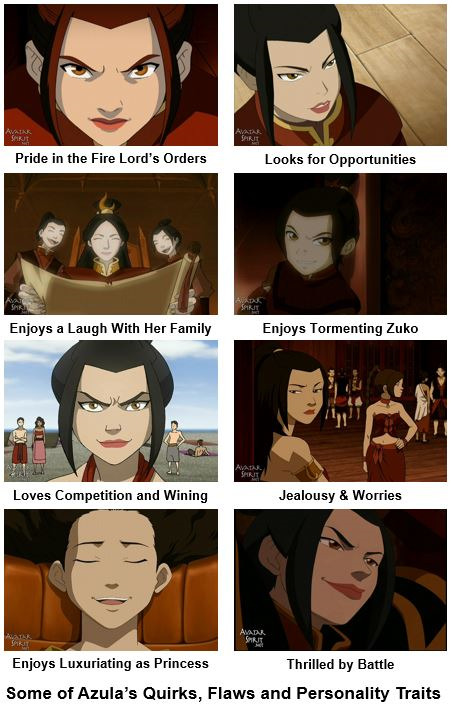
Remember what Azula’s Goals are: be with her father, be the greatest leader in Fire Nation history, and have a parent to help her. For two of those, her wickedness will both help and hinder her.
Not being concerned for peoples’ feelings and having no tolerance for weakness? Makes her able to manipulate corrupt, militant organizations like the Dai Lee. Pushing Mai and Ty Lee too hard and making them resent her? It got her their cooperation, for a time, but it ended up creating the chain reaction of fear, anxiety, stress and doubt that eventually ruined her. Embracing her father’s treatment of Zuko and doing everything necessary to avoid the same? Well, she never really got “treated like Zuko”, did she?
Not having appreciation for trust and love and focusing solely on leading through fear? Makes her able to thrive in the current Imperial Government, but also incapable of adapting to failure. Teasing Zuko? Tormenting him? Perhaps her acting in “evil” ways strained her mother’s relationship with her and lead to the “monster” impression. Now that would be quite the flaw.
Azula’s wickedness both helps and hinders her, and in the case of the Finale, contributed to her downfall. Her wickedness is a flaw. It harmed her. It prevented her from achieving her Goals.
Flaws, Quirks and Personality Traits only tell half the story of a character, and in the case of Azula, they’re not enough to understand who she is and what she wants, and more specifically, they’re not enough to advance her story in the Post-Finale world.
The Distortions of the Mirror Scene
By not paying attention to the two other pivotal Azula scenes in the Finale, the Fandom and Bryke developed a distorted, myopic understanding of the Fire Princess where mental illness, unexplained issues with her mother and violent action against hallucinations comprised the sum total of her complexity.
As a result, just about every piece of the Mirror Scene, from physical actions to key words, along with Azula’s Flaws, Quirks and Personality Traits ended up becoming stand-ins for her Goals, Motivations and Conflicts in official franchise content: The Search and Smoke and Shadow.
By focusing on Azula’s feelings and feelings alone, the Mirror Scene wound up becoming perceived as the pivotal scene for exploring her depth and even became the source of Bryke’s understanding of her when they wrote the comics. Take a look at these panels from The Promise and The Search to see what this means:

Where are her unresolved feelings concerning her father?
Where is her relationship with her country?
Where is her connection to the “Princess” in her name?
This is not to say that Azula’s time in the asylum couldn’t have resulted in her developing such extreme feelings for her mother. In fact, it does make a certain amount of sense: if she is spending her days racked by endless, gut-wrenching shame, humiliation and hopelessness, then the idea of her temporary psychosis from the Finale getting worse is reasonable; it becomes a Conflict for her to overcome.
However, this is not portrayed as what has happened to her. Instead of the Azula from the Finale getting worse, we get the Azula from the Mirror Scene falling off the cliff; all of her complexities from the Finale are absent. Once more, it isn’t that Azula couldn’t have gotten worse, she definitely could have, it’s that Azula’s relationship with her mother alone does not explain the depth of her complexity established in the Finale, which includes her father and country. If she really is suffering from gut-wrenching shame, humiliation and hopeless, leading her to succumb to wacko delusions about her mother, those feelings have to be coming from something already established: her father and country.
If you think I’m cherry-picking, go back through The Search. Scenes like the above happen over, and over and over again with zero mention of anything close to her Goals and Motivations from the Finale. Remember, feelings are not Goals or Motivations; crying about “destiny” and having “proof” in a dream sequence are not enough, especially when the Finale already established the myriad of things she wants, why she wants them and why she can’t have them.
In The Search, Azula is not shown to be motivated by a sense off shame or humiliation over her defeat in the Finale, or sense of responsibility for failing to stop Zuko’s take over of the country. You would expect that someone who wanted to be “the greatest leader in Fire Nation history” would not be dismissive of what their failure resulted in, whether or not her enemies had outside help or not. The closest The Search comes to giving Azula Goals and Motivations separate from her mother is wanting to claim the throne from Zuko over arbitrary reasons of “destiny”. Never in the Finale did Azula espouse “destiny” or a desire to be Fire Lord just for the sake of being Fire Lord; it was tied to her desire to be the greatest leader and please her father. Instead, Azula spends the entirety of The Search lashing out at hallucinations of her mother and wanting to make the voices stop. Not once is her father or country mentioned as Motivation.
Azula does not get portrayed like this unless “love” and “hallucinations” and “being confused” and “my mother thought I was a monster” are taken as the full extent of her Goals, Motivations and Conflicts. You do not portray Azula like this if you properly understand the Mirror Scene as depicting a troubled teenager believing their parent is lying to them (”Don’t pretend to act proud. I know what you really think of me...”) versus her conscience trying to “weaken” her with “love” (”Same as always, Zuzu. Even when you’re strong, you’re weak). In The Search, Ursa is not Azula’s parent in any capacity, past or present, and we are not shown how she has come to feel this way.
You do not make Azula’s relationship with her mother this drastic unless you fully believe that everything about Azula can be acquired from the Mirror Scene and the Mirror Scene alone, and it appears this is precisely what Bryke believed.
In a way, the Azula in The Search is an answers to the macabre question: “How much further out of her mind can Azula go if she believes her mother is the source of all of her problems and every key word and emotion from the Mirror Scene is carried forward?”
To further this point, here are some key lines from the interview in the Sozin’s Comet novelization where Bryke discussed Azula’s “evil”, with commentary added:
“As The Beach and Sozin’s Comet showed, she has a lot of unresolved issues with her mother.”
Yes, it appears she does. Where do they come from?
“She really feels that her mother didn’t lover her as much as Zuko, and this drives her crazy, literally.”
Wait, what? She was already falling apart by the time the hallucination occurred. What about Mai and Ty Lee, her father and her role as Princess?
“There are some truly evil people in the world, but in the case of Azula, her repressed emotions and jealousies corroded her spirit and made her become that way.”
Made her become what way? She’s the Fire Princess; she enjoys being mean and powerful, and she just had a mental breakdown and fell flat on her ass in front of her nation’s capital. What “corroded spirit”?
“And who knows, she might have a chance to heal.”
Heal from what, her villainy? Her personality? Her breakdown? She wouldn’t be Azula anymore?? What are you referring to??
By itself, the Mirror Scene does not reveal Azula’s Goals, Motivations and Conflicts. By itself, it only shows examples of things that give Azula grief and confusion and clearly recognizable human emotions that the viewer can relate to. In other words, feelings.
Feelings are not Goals. Feelings by themselves are not even Motivations; they have to be in the context of wanting, needing, desiring something in order for them to become Motivations.
“My mother thought I was a monster” is not a want or a need or a desire. It is a statement of a Conflict and nothing more, whereas, “My mother thought I was a monster (Conflict) and this eats at my soul (Motivation) because I want my mother in my life helping me (Goal)” is getting somewhere.
Using the mirror scene as a sole reference is how Azula’s throwing of the hair brush in the Finale turns into shooting lightning at water, or her gripping her hair and screaming to reject the words of “love” from the hallucination, or her desiring to literally murder the physical embodiment of the hallucination; it’s because the writers are trying to wring every drop of meaning from this out-of-context interpretation of the Mirror Scene.
It’s how her want for the throne is based on vague, brand new notions of destiny instead of duty to her country. It’s how you get not a single word from Azula about wanting to correct her image in the eyes of her father... Because the Mirror Scene didn’t say any of this; it was all about her mother, love and confusion.
And don’t think this myopic, excessive emphasis on the Mirror Scene and Azula’s feelings was limited to Bryke. Oh no. Nobody is getting off easy.
Take Aaron Ehasz’s comments about his brain bugs for a Post-Finale Azula arc in a hypothetical Season 4, which many fans have found inspiring and also devisive:

He focuses on “pain”, “love”, “feelings”, “change”, even uses the magic word “redemption”. These are all abstract. Where are Azula’s Goals, especially those revealed in the Finale? Where is “I will be the greatest leader in Fire Nation history?” What does she want to accomplish in this Season 4? What will she be doing? Feelings are not enough. Motivations are not enough. There have to be Goals attached to them.
“Azula is in the depths of her abyss” is not a Goal, whereas “Azula is in the depths of her abyss (Conflict) because she wakes up every day with gut-wrenching feelings of shame and humiliation that she wants to go away (Motivation), so she wants her normal life back (Goal)” is, once more, getting somewhere. And better yet: “she will do whatever it takes to end her misery” is the beginnings of a story.
Now take a look at what author Gene Yang wrote when he was asked by a fan if it is possible for Azula to have “happy closure.” What does “happy closure” mean? Well, as someone who now understands Goals, Motivations and Conflicts, you know that it means a character achieving their Goals and no longer having any Conflicts, but what is Gene Yang’s answer?

He says it’s not even possible.
Of course it’s possible for Azula to have “happy closure”. Any character can. It’s a matter of them achieving their Goals or losing the Motivation for them. She’s not a robot.
But hold on! Wasn’t Gene Yang just being vague? Wasn’t he only trying to make a point to get the fan to think for themselves? Maybe even hide the plot of Smoke and Shadow?
You could have thought that at the time, but as we now know from Smoke and Shadow, Gene Yang wasn’t making a vague, thought-inducing comment to that fan. He was stating that Azula can’t achieve her Goals or change her Motivations. Remember what her Goals and Motivations were from the Finale: be with her father, be the greatest leader in Fire Nation history, and have a parent who can help her. None of those Goals and none of the Motivations behind them were resolved at the end of the Finale, or by the end of The Search; they were ongoing. We didn’t even find out if they had changed between the Finale and The Search. Now take a look at these two scenes from Smoke and Shadow:

Not even Azula’s mother and brother know what she wants, and in fact, neither do Gene Yang, Bryke, and for the longest time, the majority of the Fandom.
Why can this conclusion be made about the Creators? Because Azula’s Goals, Motivations and Conflicts established in the Finale, and which had not been resolved by the end of The Search, disappeared entirely in Smoke and Shadow.
Without hallucinations, without her mother’s voice giving her haunting assurances of love, without feelings directly attached to the Mirror Scene, there is nothing else inside Azula in the minds of the Creators. Once she runs away into the forest at the end of The Search, after hearing hollow platitudes from her brother, she becomes “weightless… free”.
There are no unresolved issues with her father. There is no goal to be the greatest leader in her country’s history. There is no desire to absolve herself of her failures to prevent the old regime from falling. There is no sense of personal responsibility for failing to stop Zuko and thereby prevent the destruction of the colonies. There isn’t even a relationship with her mother if it can’t be tied to hallucinations.
By placing all emphasis on the Mirror Scene in the comics, everything about Azula became searching for “love” and feeling “confused” because those were the key words used by the hallucination in the Mirror Scene. “Love” becomes just a word she needs to hear (“I love you, Azula” from the hallucination, “You’re still my sister” from Zuko) without regard to who it comes from (supposed to be from her parents) or whether it is actually meant (there is no reason for Azula to believe Zuko, or even seek it from him; he’s not a parent and he’s a mortal enemy responsible for her ills).
There was nothing about one’s duty to their country as a Princess; there was nothing about living up to her parents’ standards, both parents’ standards; there was nothing about becoming the greatest leader in Fire Nation history, and becoming Fire Lord (either via the letter or vicariously in Smoke and Shadow) is not becoming the “greatest leader” to Azula. It simply means being Fire Lord. This is what was revealed in the Finale when she still wasn’t satisfied despite being on the verge of being crowned. And finally, there was nothing about resolving her feelings of fear, anxiety, stress and doubt that resulted from her failures to achieve her Goals during the Finale.
So why did this happen?
On the Creators’ side, it’s impossible to speak for them, but judging by the interview in the Sozin’s Comet novelization, not even Bryke paid attention to the Phoenix King and Throne Room scenes. They became myopic about Azula’s relationship with her mother too, and forgot all about her other relationships and motivations, namely those involving her father, country and self. As a result, their understanding of their “favorite villain”, as they described her in the Art of the Animated Series, became a vacuous, distorted mirage (literally a ghost in Smoke and Shadow) of her former self and her Arc that was begun in the Finale was abandoned entirely.
On the Fandoms’ side, it’s a combination of things:
1) The Fandom had not been “primed” to have their view of Azula challenged, so the “subtleties” of her relationship with her father and country got overshadowed by Ozai donning a ridiculous outfit, Azula banishing people in a blue-colored throne room and “Oh my god, Ursa!!”;
2) The Mirror Scene was “sexy”; it was eye-opening, jaw-dropping; it made you go, “Holy crap!” The eerie violin score was haunting, the voice acting was top notch and it had big, bad Azula on her knees sobbing like a wimp. Naturally, it stood out in peoples’ minds whereas the Phoenix King and Throne Room scenes fell behind the desk, and thirdly;
3) Azula’s relationship with her mom is primarily about feelings. A show as visually stunning and well-voice acted as Avatar is, first and foremost, about inspiring feelings in the viewer. In fact, all stories are about inspiring feelings. The Fandom did not go into the Finale looking to learn about Azula’s complexities, so The Phoenix King and Throne Room developments did not receive the same amount of intense, emotional attachment as the Mirror Scene. Simply put, the hallucination of a mother telling her teenage daughter that she loves her, and that same teenage daughter collapsing into tears over it, is much more heart wrenching and relatable to kids and teenagers than the pressures of ruling a military feudal dictatorship in the image of the Big Bad.
Summary
To understand a fictional character, you have to know their Goals, Motivations and Conflicts. Next, you have to identify their Flaws, Quirks and Personality Traits, which add distinction and depth and provide internal sources of Motivation and Conflict.
Azula’s Goals, as revealed in the Finale, are as follows:
Be With Her Father;
Be the Greatest Leader in Fire Nation History;
Have a Parent Who Can Help Her;
Azula’s Motivations, as revealed in the Finale, are as follows:
Not Be Treated Like Zuko;
Pride & Belief in Her Royal Duties;
Alleviate the Stress Caused by Her Goals;
Azula’s Conflicts, as revealed in the Finale, are as follows:
Her Father Doesn’t Want Her;
She Struggles to Be a Great Leader;
She Doesn’t Have a Parent Who Can Help Her;
The Mirror Scene and Azula’s relationship with her mother are not enough to reveal her Goals, Motivations and Conflicts. The Mirror Scene, by itself, is only a Conflict, whereas the two additional scenes in the Finale—the Phoenix King and Throne Room scenes—provide her other Goals, Motivations and Conflicts that make the meaning of the Mirror Scene clear: a teenager looking for the support of a parent.
Excessive emphasis on the Mirror Scene and, by extension, Azula’s relationship with her mother, have created a distorted view of Azula that has harmed her portrayal in the comics and stymied explorations of her value to the Franchise. Instead of Azula being a feudal military leader-in-training who struggles with both her feelings and Goals, she has been reduced to both a myopic interpretation of the Mirror Scene and is limited to her Flaws, Quirks and Personality Traits, none of which are enough to advance her story in the Post-Finale world.
Closing Remarks: How to Move Forward with Azula
For those fans of Avatar who are curious about what to do with Azula’s Goals, Motivations and Conflicts, and makes use of her Flaws, Quirks and Personality Traits, you have to ask this question: what value can more Azula bring to Avatar?
No individual character will be more popular than the franchise itself, especially a hated villain who might have the ability to change and grow. Below is a screenshot from Google Trends showing the relative popularities between Azula, Zuko and Avatar: The Last Airbender search results. It demonstrates that secondary characters like Azula are nowhere near as popular as the franchise they are a part of.

In order to make a character like Azula worth exploring in detail, they have to be made important to both the Main Cast and the Franchise at large. It’s not enough to just have “a” story about Azula; her Goals, Motivations and Conflicts have to be valuable to the Heroes and world of Avatar. There are no hard and fast answers as to how to achieve this, and the franchise has clearly moved on from Azula, but with Avatar being rebooted in live action form, here are some ways to begin approaching this in case the live action version moves into Post-Finale territory.
Azula’s Unique Selling Points
These are the things that make a character fun, interesting and enjoyable to have on screen. In other words, likable. Toph’s cheekiness, for example, is a Unique Selling Point. Aang’s free-spiritedness is a Unique Selling Point. These can also be called the “fun and games” of a character. They are what viewers want to see, hear and feel when these characters appear on screen. For example, if Toph and Azula are going to appear on screen together after Azula is taken out of the asylum, there better be sass, like in Day of Black Sun.
Azula: Um, right. I think your friend just said that genius. And since you can't see, I should tell you I'm rolling my eyes.
Toph: I'll roll your whole head!
So what are some of Azula’s Unique Selling Points?
Blue fire;
Lightning;
Skilled martial artist and firebender;
Royalty;
Intelligent;
Snarky and smug;
Smooth-talking;
Confident;
Female in a militarized society, but who does not eschew femininity;
Makes “princess” associated with power and aggression, not passivity;
Dark subject matter surrounding her (e.g. the unresolved emotions in the Finale);
Determination;
Emotional fragility;
Youth (the kid/teenager themes of the show).
Azula’s Value to the Franchise
This is what makes a character more than just a background character or plot device. It’s what makes them create new fans of the Franchise, add interest, sell product. In other words, add value.
Haru, for example, adds little value to the Franchise because he’s just a regular Earthbender with no Unique Selling Points and his relevance to the plot and characters is over. Iroh, on the other hand, is absolutely full of Unique Selling Points and provides insights into the Avatar world and its characters. His perspective adds value. His abilities add value. His importance to the Heroes adds value.
So what makes Azula relevant to the franchise beyond just being a villain?
She can teach us about firebending through her blue fire and lightning;
She can provide an aggressive firebending female, which ATLA does not have;
She can teach us about the Fire Nation through the eyes of someone who doesn’t appreciate Zuko’s transformative policies;
She can teach us about what it means to be a girl/woman in the Fire Nation;
She can teach us about the Fire Nation’s military, government and history;
She can represent the “old” Fire Nation that Zuko must reform.
Azula’s Critical Relevance to the Heroes
Since any story is ultimately about its characters, Azula not only has to be relevant to the Heroes, but critically relevant to justify deeper exploration. So to which characters is Azula critically relevant?
Ursa, Zuko, and to a lesser extent, Iroh.
As Azula’s mother, Ursa will be implicitly concerned with her daughter’s well-being regardless of how us fans feel; as a young member of the Royal Family who can firebend, she is relevant to the Royal Family’s continuation, and by extension, Zuko’s legacy; and as the sister of Zuko, she is Iroh’s niece, in other words, family.
Essentially, if there is any drama surrounding the Royal Family in the Post-Finale world (and how could there not?), Azula is a fundamental part of it. I call this the “Royal Family Drama Triangle”.

Azula’s Critical Importance to the Plot
Azula must also be essential to both resolving the Primary Conflict of the story. This forces the viewer or reader to implicitly care about Azula’s Goals, Motivations and Conflicts since she impacts the fate of the Heroes directly.
What are some of the problems that Azula can be critically necessary in solving? To begin answering this question, you have to sit down and think about what kind of problems the Heroes would face in the Post-Finale world. This article series, How to Develop Avatar’s Season 4, provides one such scenario.
One way to answer this question is to look at the unchanging aspects of Azula’s character, the thing’s that don’t go away whether she is a villain or not, and these are: 1) she is a young, firebending member of the Royal Family; 2) she is a member of the old regime that Zuko must reform; and 3) she is Ursa’s daughter. This suggests that the type of plot that Azula can take a major role in is one where the Fire Nation and Royal Family are at the center. Princess Azula of the Fire Nation might not care about the rest of the world like Zuko, but certainly she will care about the Fire Nation and its Imperial Government.
Some of the specific problems in the Post-Finale world that Azula can help solve:
Quelling unrest in the Fire Nation over Zuko’s policies;
Stopping a rebellion against Zuko and the Imperial Government;
Saving the Royal Family from assassination/coup (i.e. eradication);
And others if you can come up with them.
How to Develop an Arc for Azula
Finally, how do you go about developing an Arc for Azula in the Post-Finale world? Remember that to understand a character you need to identify their Goals, Motivations and Conflicts. This also applies to creating a character, but when it comes to creating an Arc, you have to add in the Epiphany.
A character’s Epiphany is simple to describe, but difficult to execute: it’s how they grow and change in order to either achieve their Goals, or lose their Motivations and move on in life. The Epiphany is the result of the character’s journey to achieve their Goals combined with their Motivations, Conflicts, Flaws, Quirks and Personality Traits. It is, in essence, what the story is all about. For example, Zuko did not arrive at his Epiphany easy and his decision to betray Iroh in Crossroads of Destiny was not a random step backwards: it was the result of everything about him. An Epiphany for Azula would undoubtedly be complicated and multi-layered, probably much, much more so than Zuko’s.
To begin developing an Arc for Azula, you first have to identify what remains of her Goals, Motivations and Conflicts from the Finale when the story picks up with her in this new Post-Finale story. Remember that she suffered a mental breakdown, was humiliated in the eyes of her nation and has been locked away in an asylum for some length of time.
Next you have to devise a new Central Conflict that drives both her and the Main Cast through the story, something that requires all of their actions to solve. Then you have to establish her new Goals, Motivations and Conflicts in relation to that Central Conflict and the Post-Finale situation she faces, and finally, you have to put her in situations that test her, make her think, challenge her values, that make her change and grow. How you do this is up to you, but her are some pointers:
Always think about her Unique Selling Points. Blue fire? Make her ability to produce blue fire important to the story and not just a thematic decision. For an idea as to how to tie blue fire into the Avatar world at large, see the article, The Science and In-World Reason for Azula’s Blue Flames.
Azula was locked in an asylum? Make it have lasting effects on her that she struggles with. She is royalty? It better be more than just a title, but responsibility and a part of her personal code. Snarky, confident, intelligent and brave? There’s a lot you can do with someone who doesn’t shy away from danger and enjoys infuriating people, especially when they have the literal firepower to back it up.
Always strive to make her add value to the Franchise. She is a female firebender, something that ATLA has a dearth of. This is good; make her femaleness mean something. Along these lines, she is a great opportunity for a “Female Power Fantasy”. Just ask R.F. Kuang about it. She is also not the victim of circumstance or the actions of others as many characters in Avatar are. This gives her a different type of change and growth story compared to Zuko’s.
Use her to talk about the Fire Nation’s militarized culture, the same culture that “pure heart and unquestionable honor” Zuko somehow has to change. Use her to reveal the Fire Nation’s history and politics as it pertains to Zuko’s rule without going into “Info Dumps” since, as a princess, Azula would naturally be concerned with those subjects. Also use her to help advance Avatar’s East Asian themes. The fact that Azula is a feudal leader-in-training and female can give you a lot of material to work with (east Asian origins article).
Maker her critically relevant to the heroes. Find legitimate reasons for why Zuko, Ursa, Iroh and even members of the Gaang would care about Azula’s thoughts and feelings; if they care we care. Don’t think this is possible? It is definitely possible.
And finally, make Azula critically important to the plot. She cannot be a side character; she is too loathed and hated and has too much bad blood with the Gaang for her presence to be tolerated without some pressing need for her to be around. Whatever role she takes, it has to be big. It has to be obvious that Azula’s involvement is required. The Gaang has to think, “Well, damn, we need Azula’s help.” Zuko has to think, “I hope she makes the right decision and helps me. I know she can.” Iroh has to think, “I hope my niece isn’t killed.” Ursa has to think, “I want the love of my daughter. I want my daughter back.”
In short, you have to make Azula important.
Remember: her Arc in the Finale was not finished. It still can.
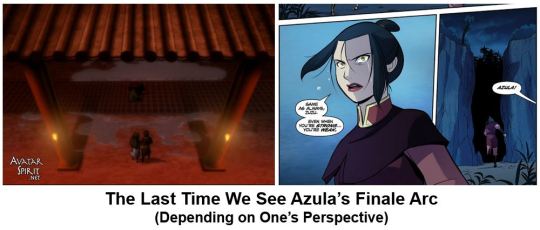
457 notes
·
View notes